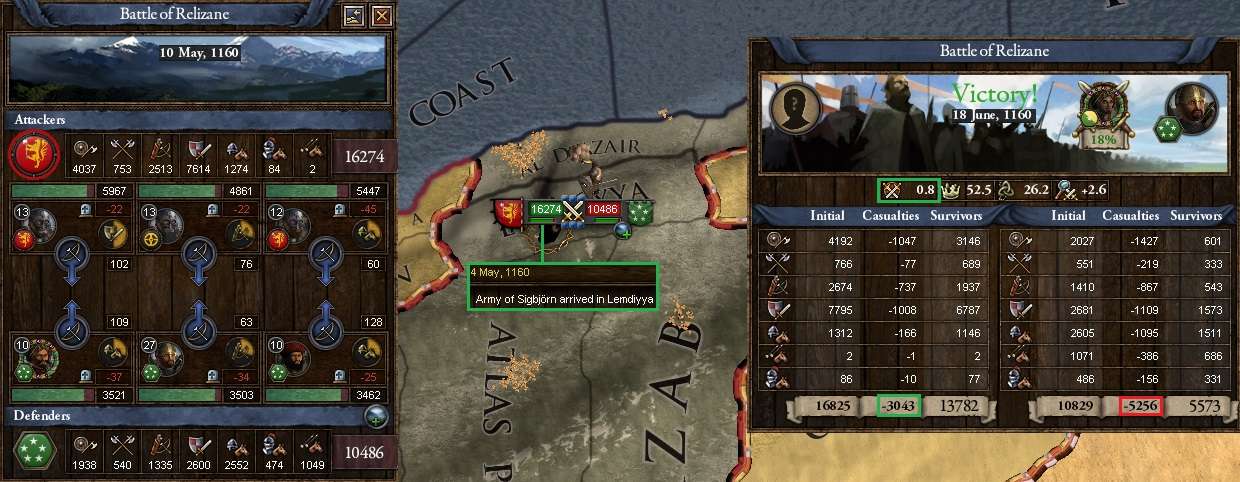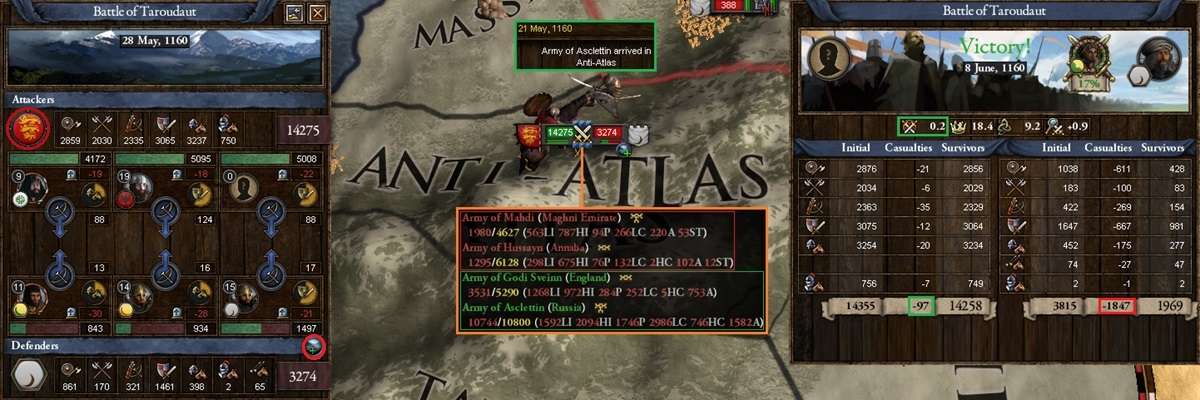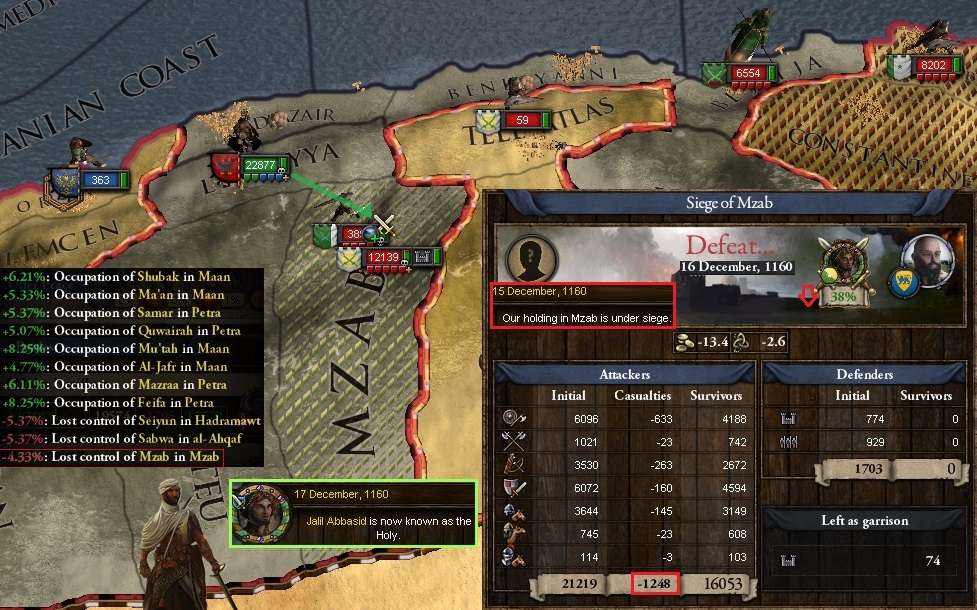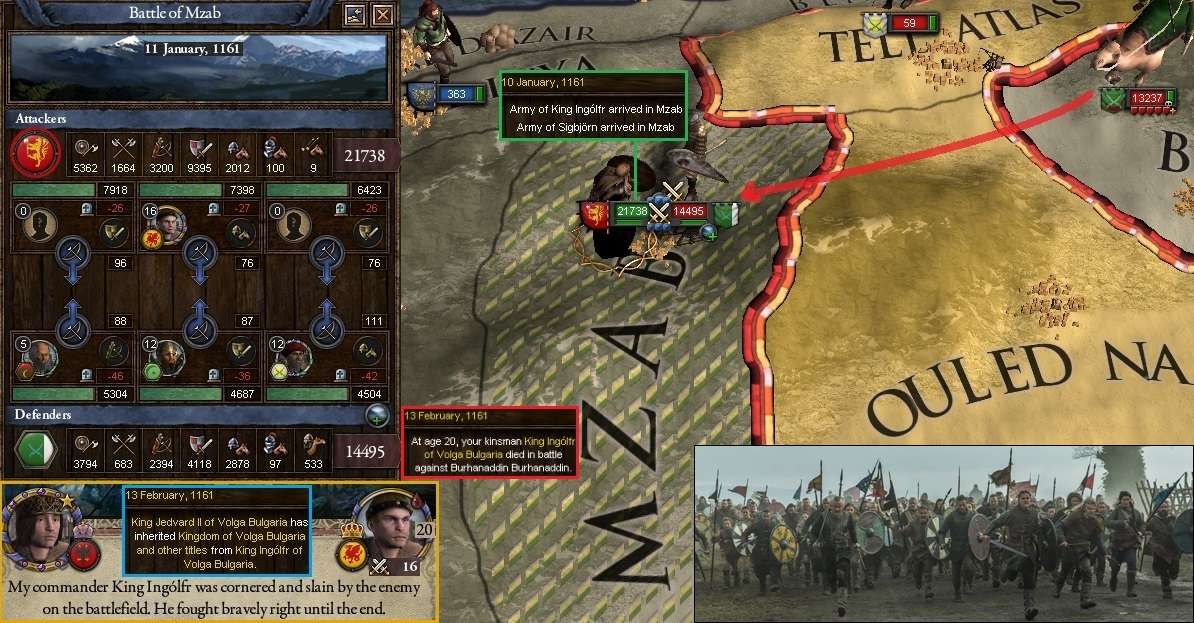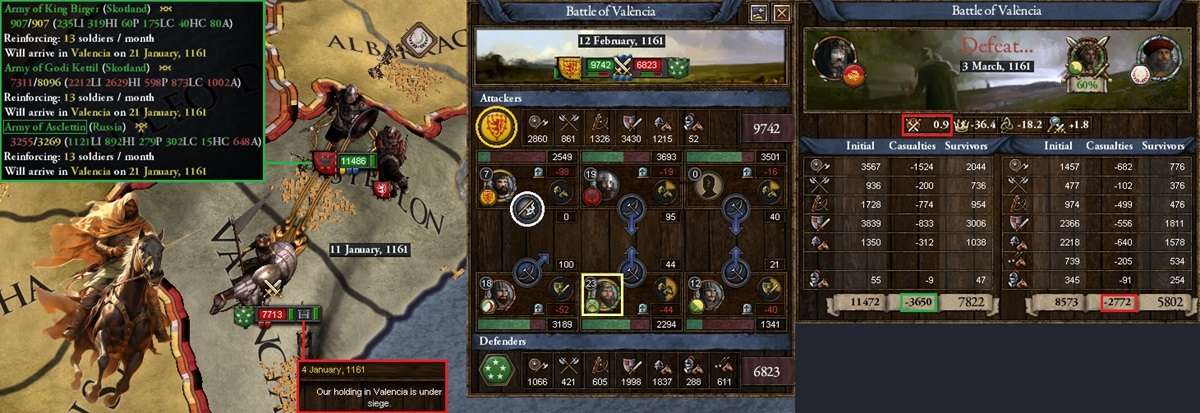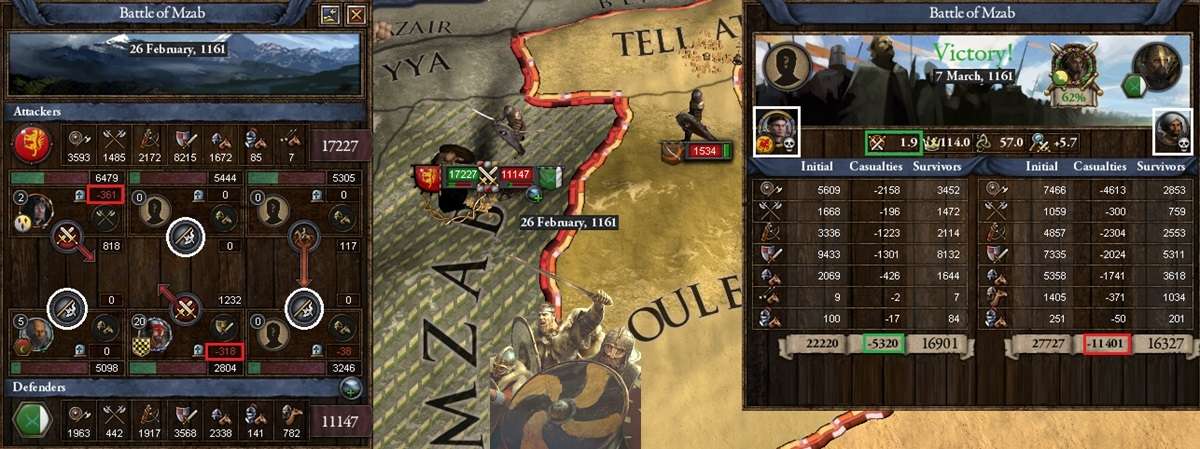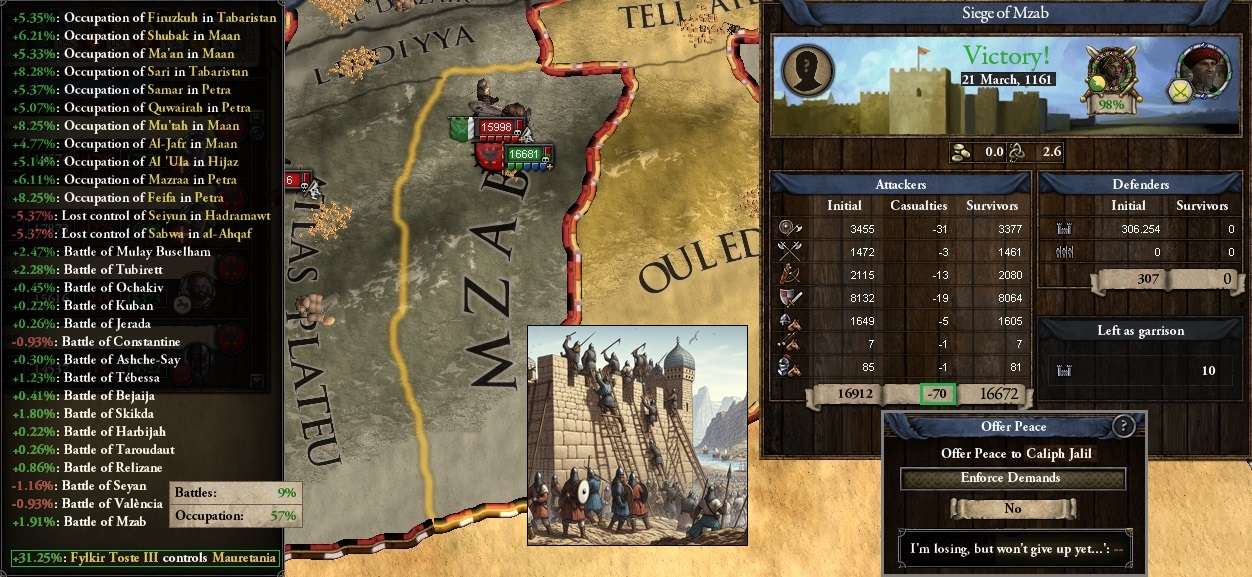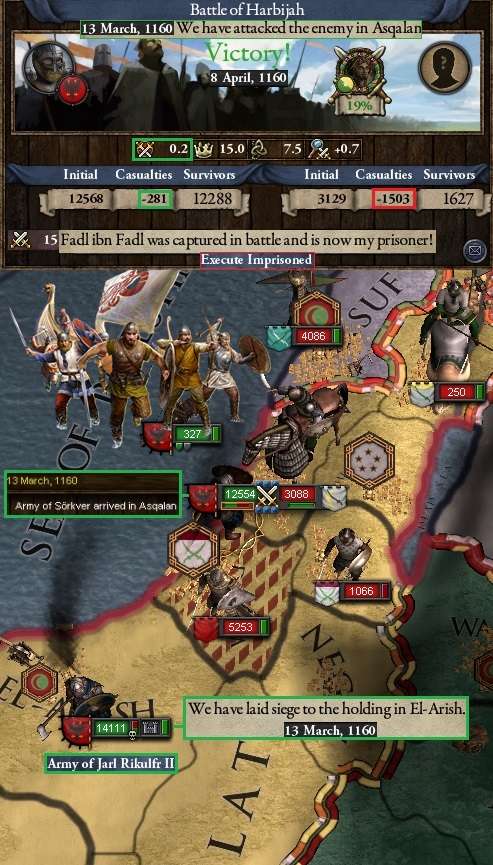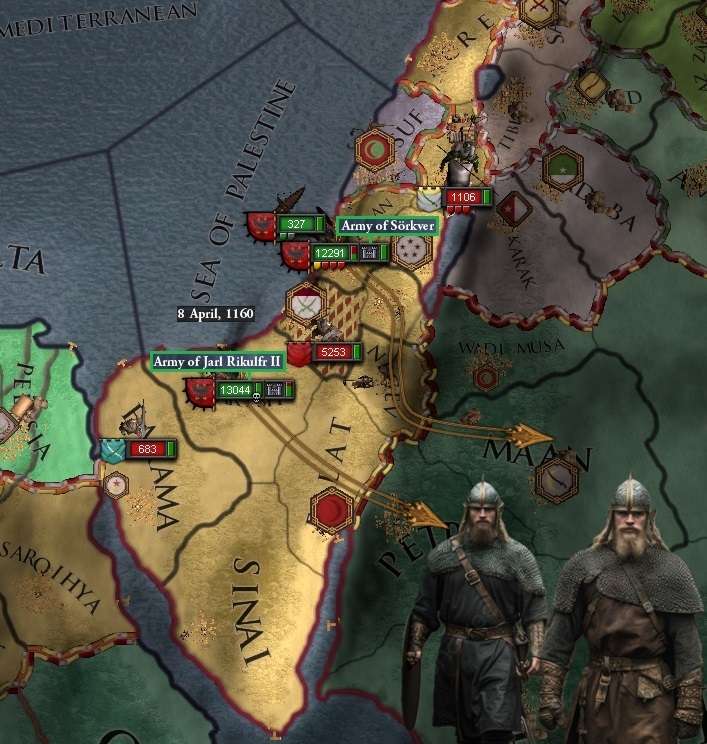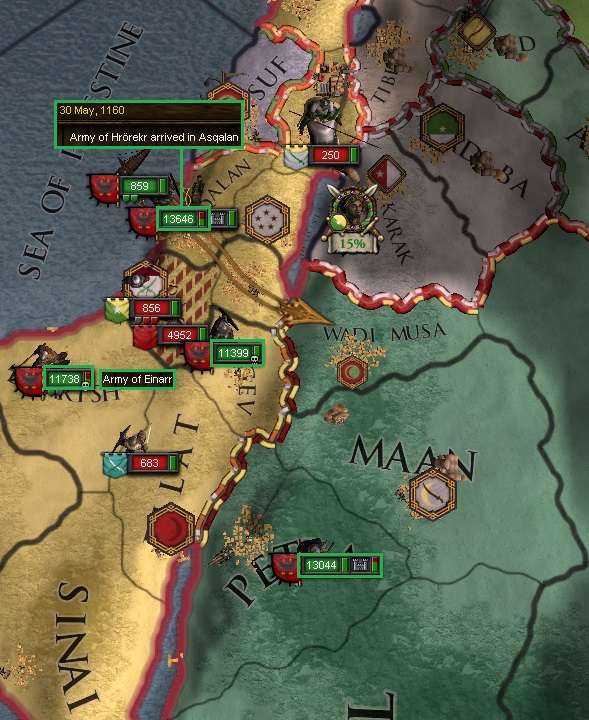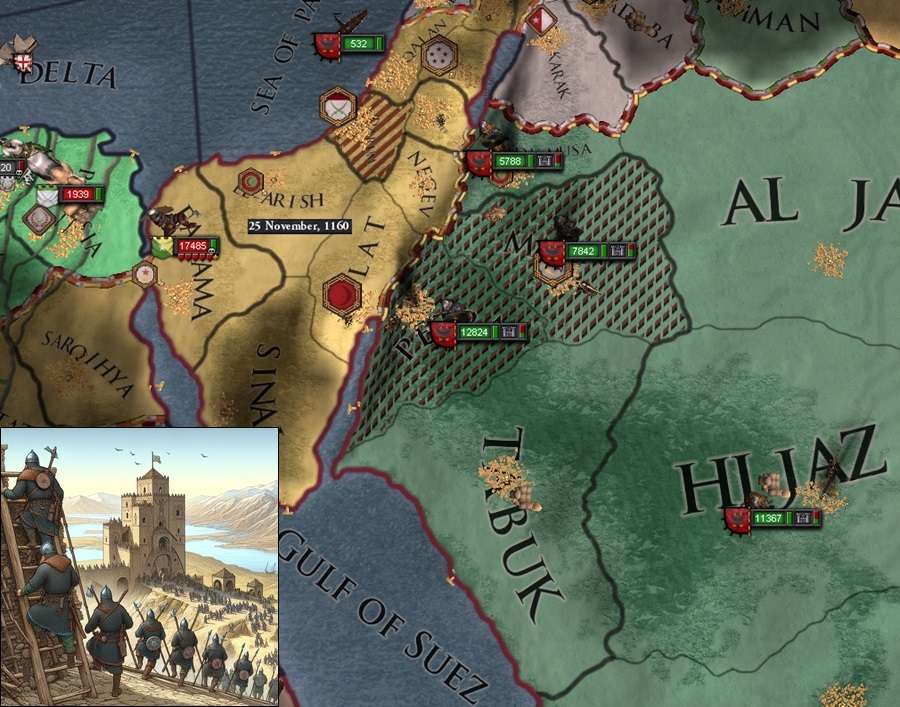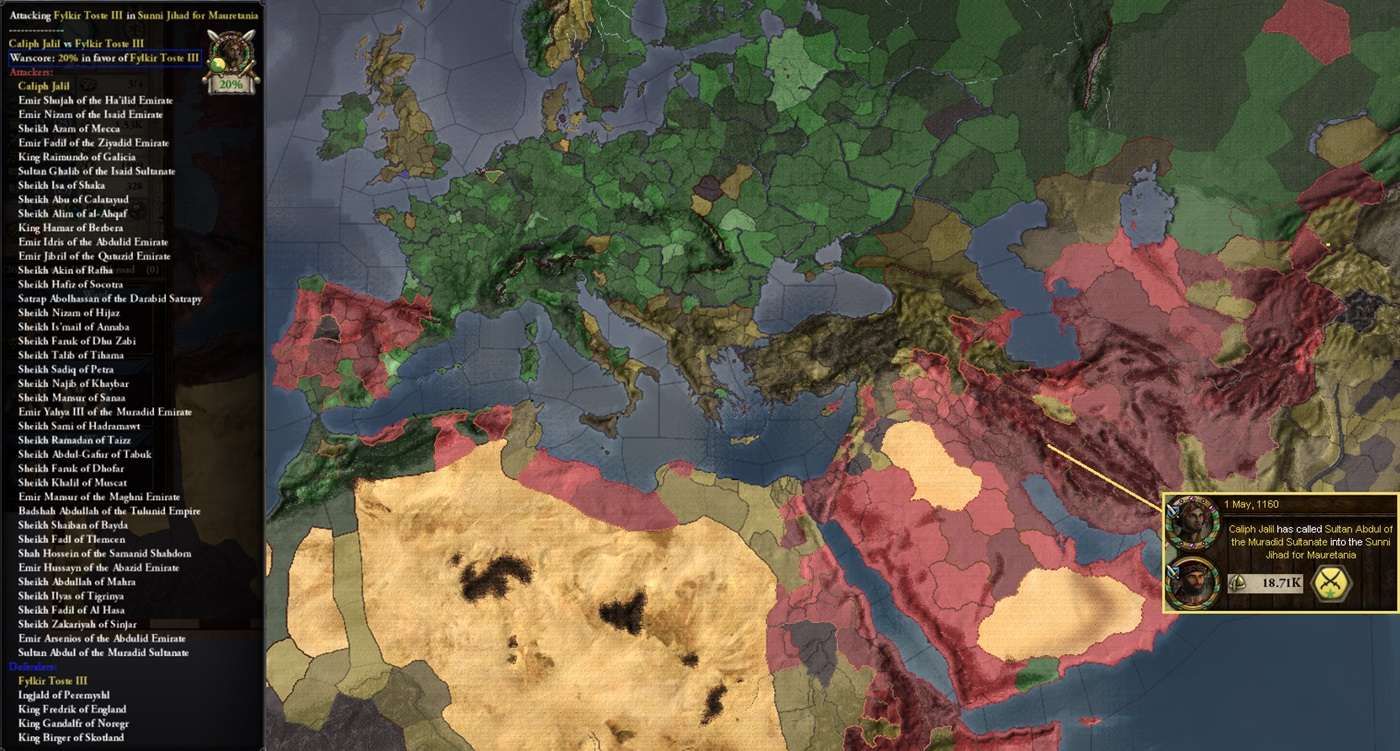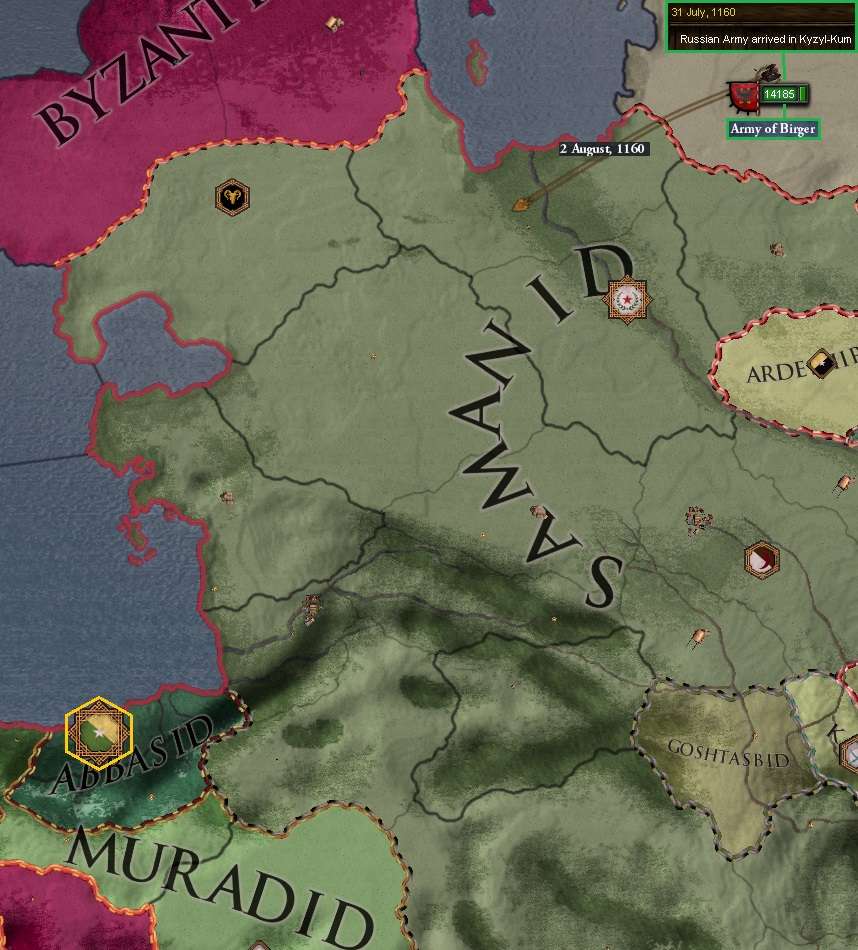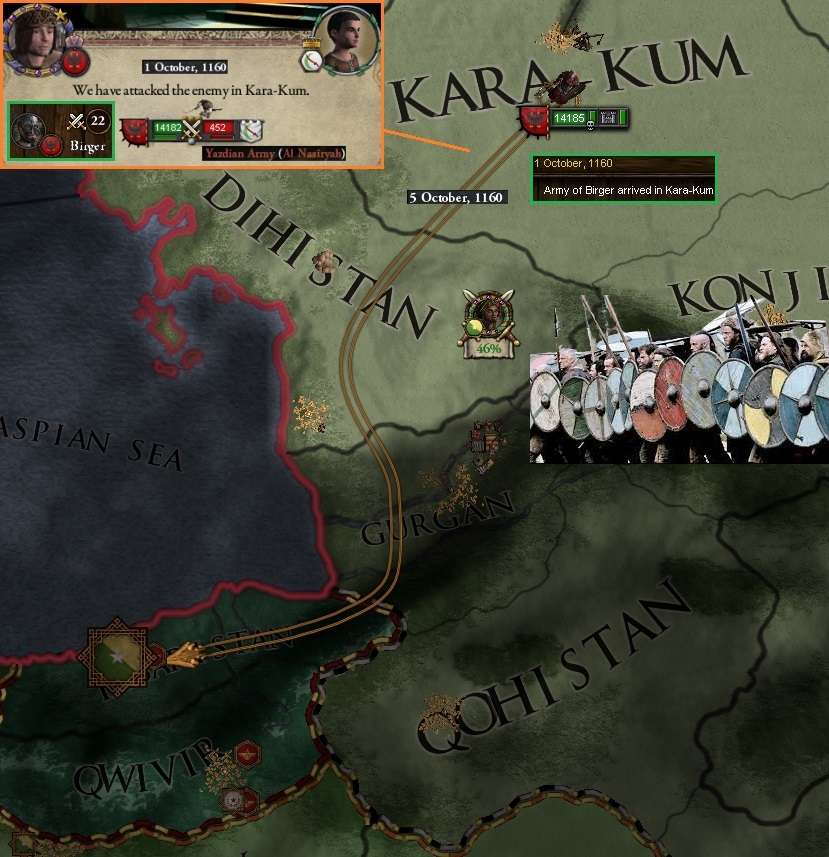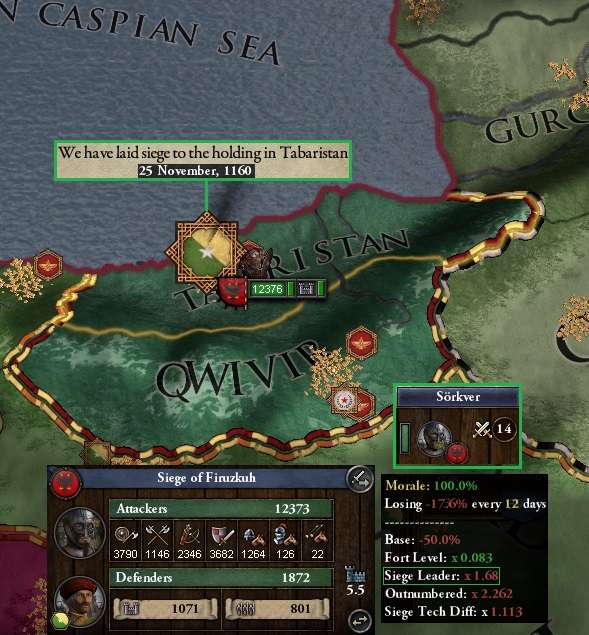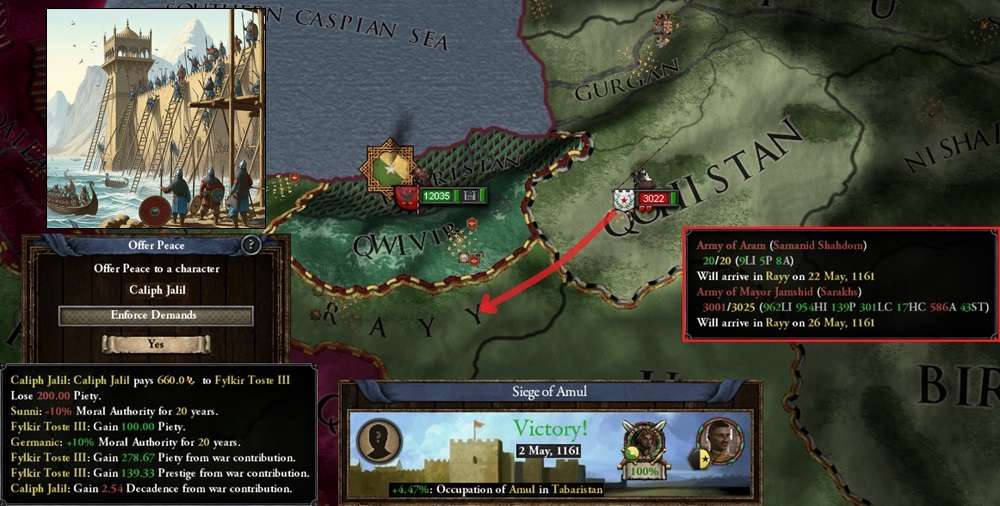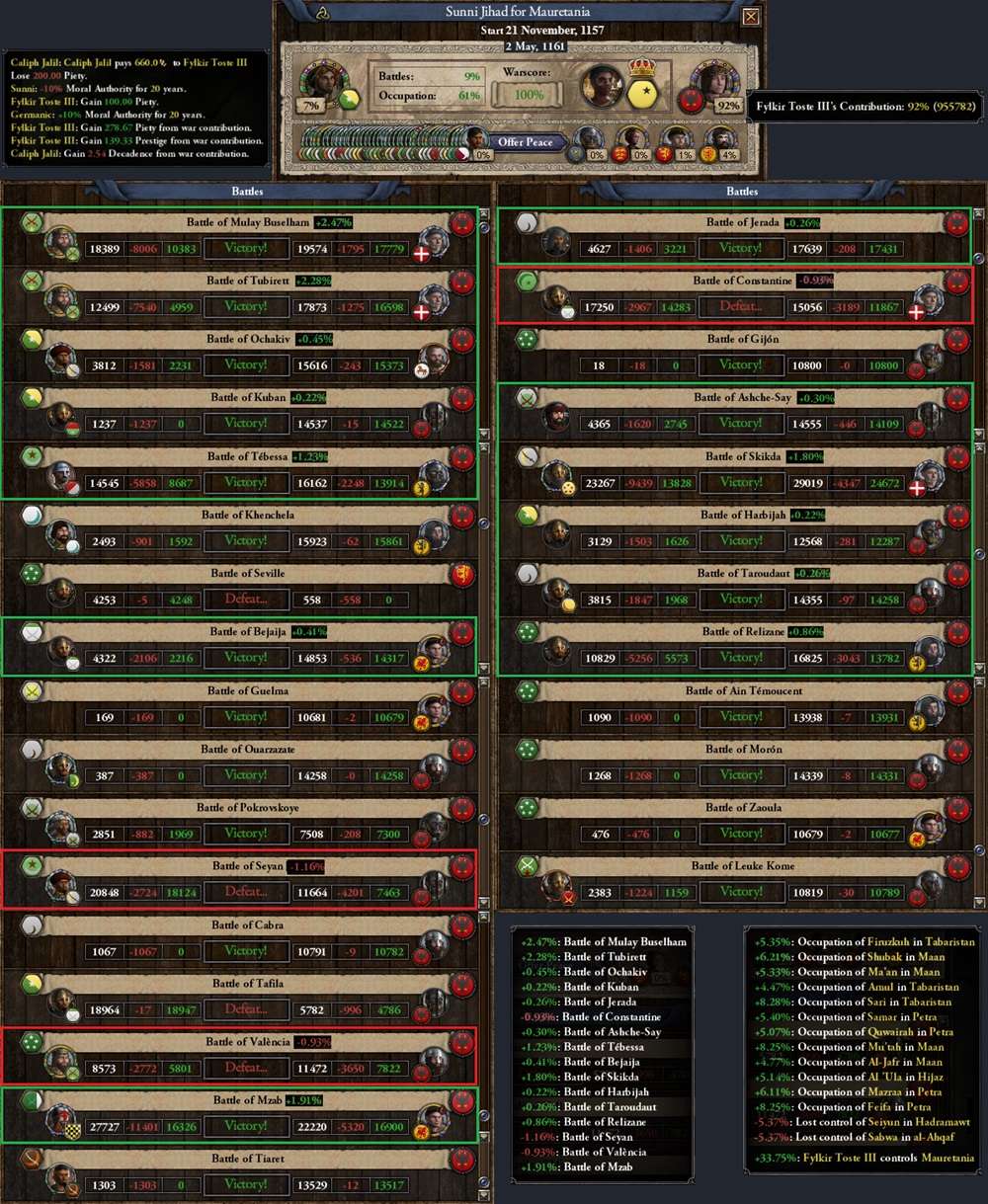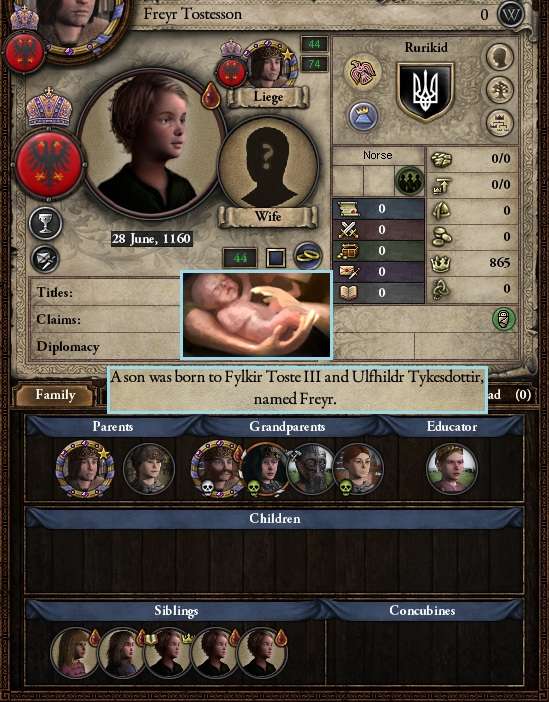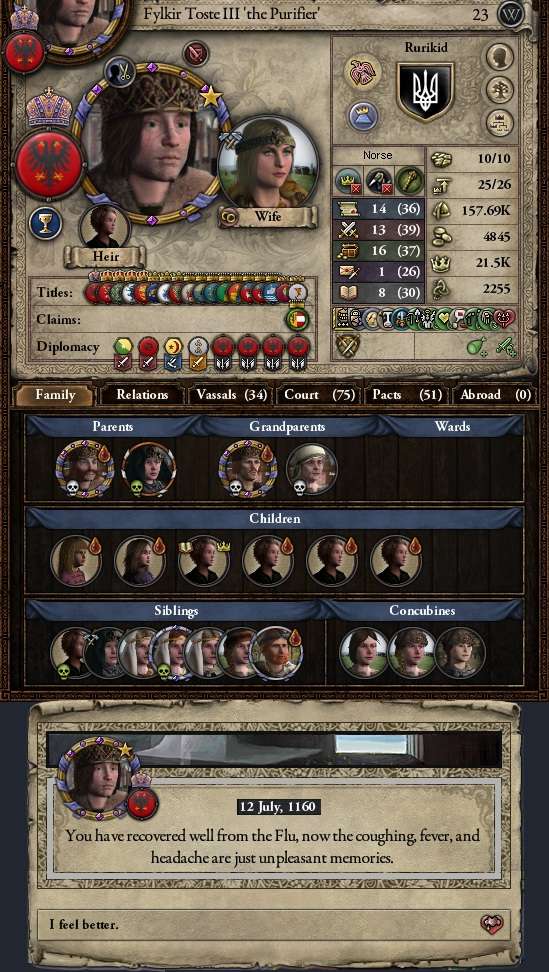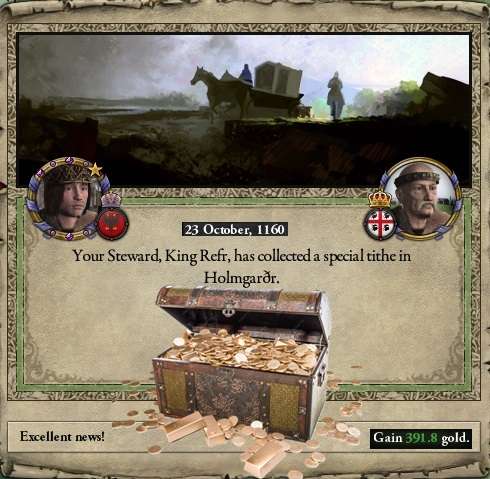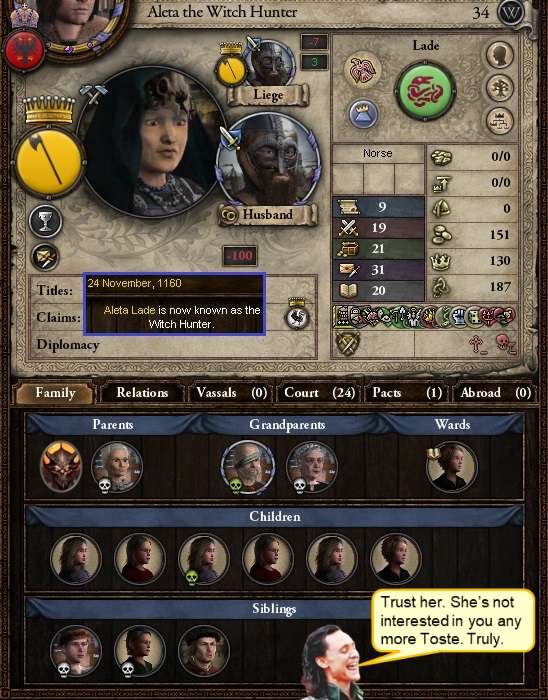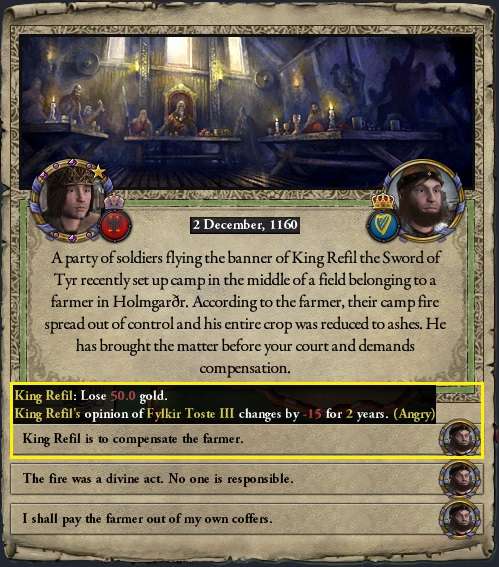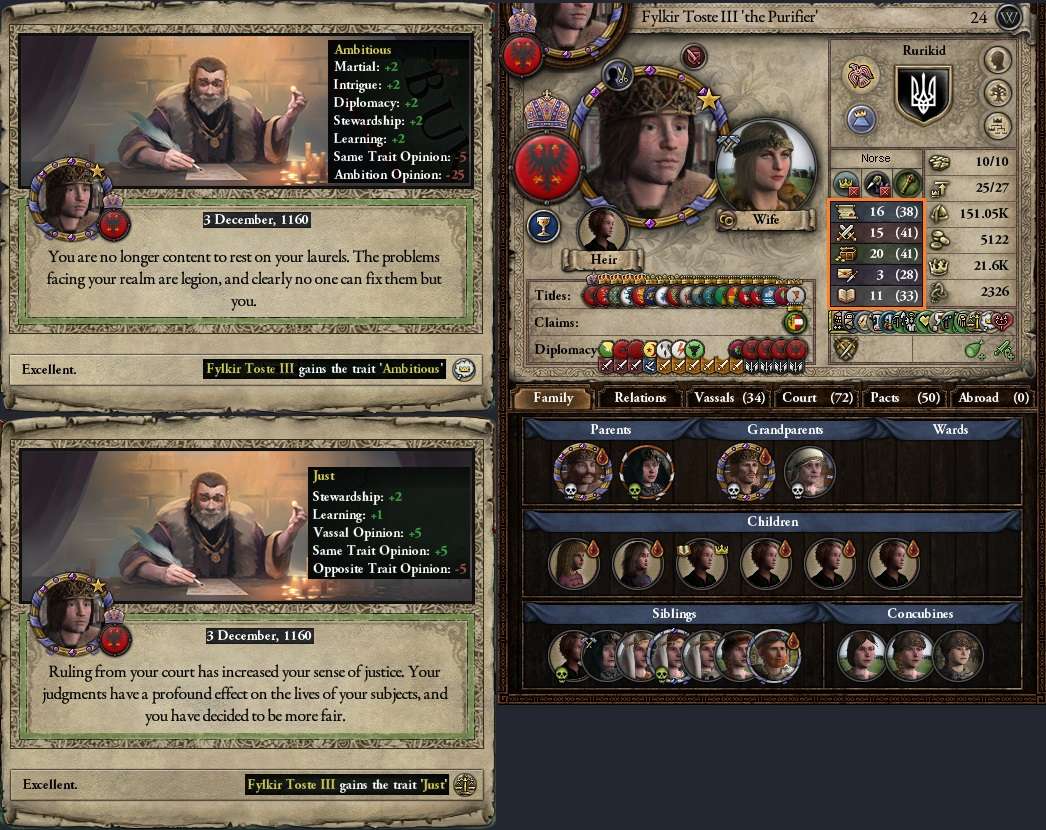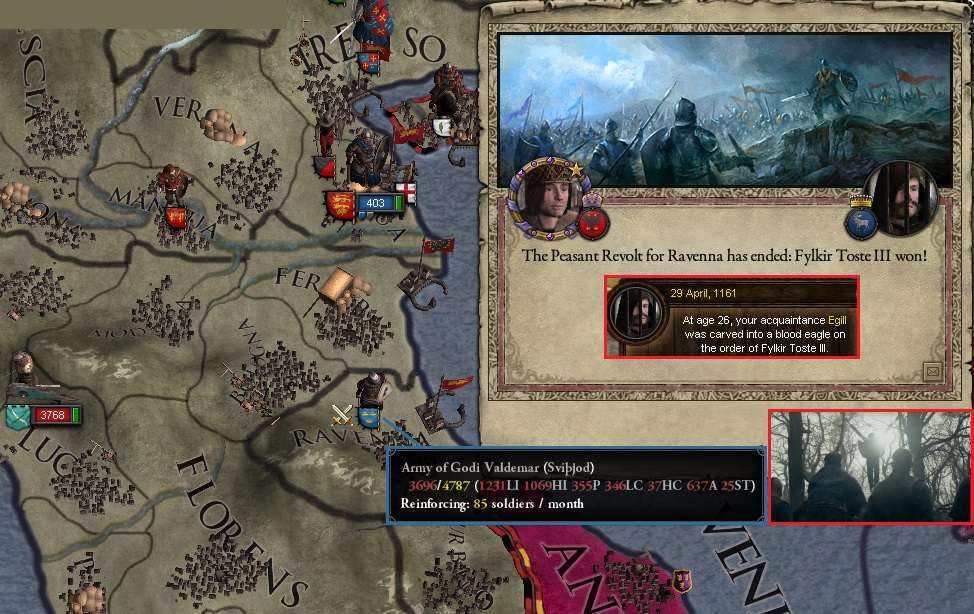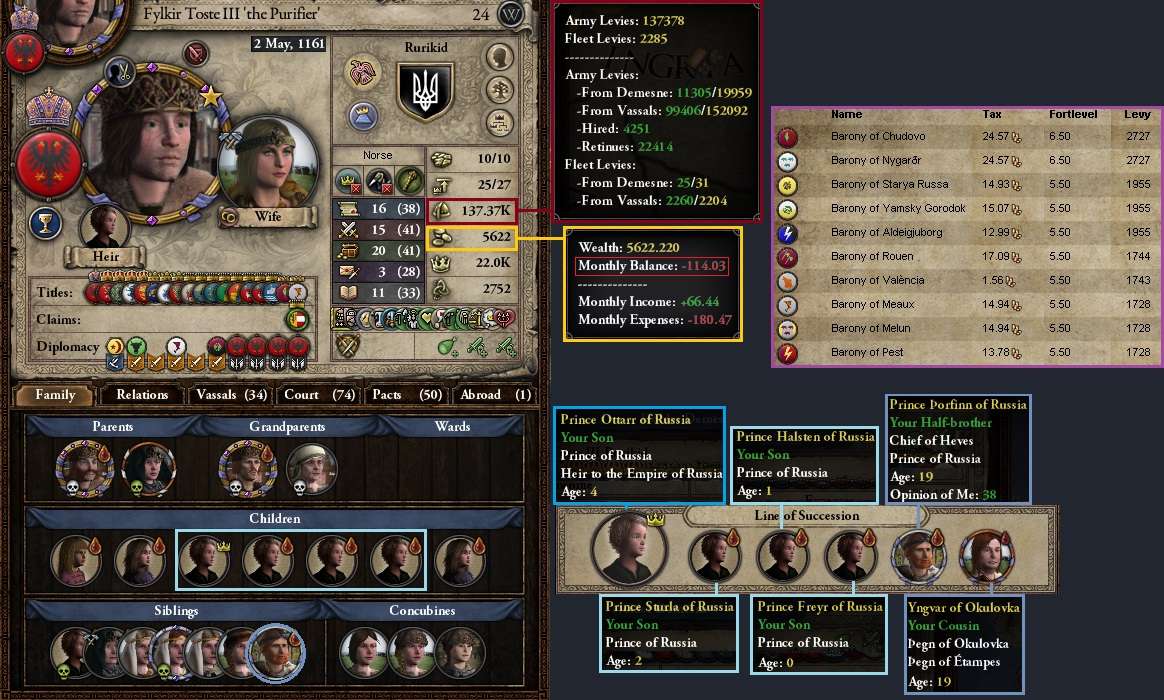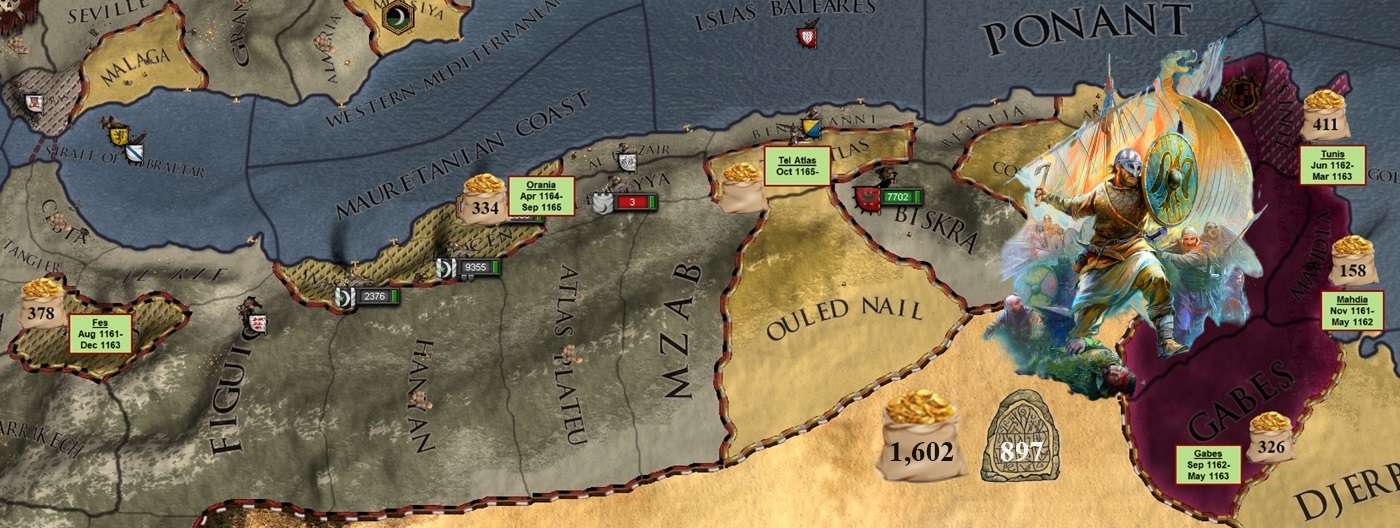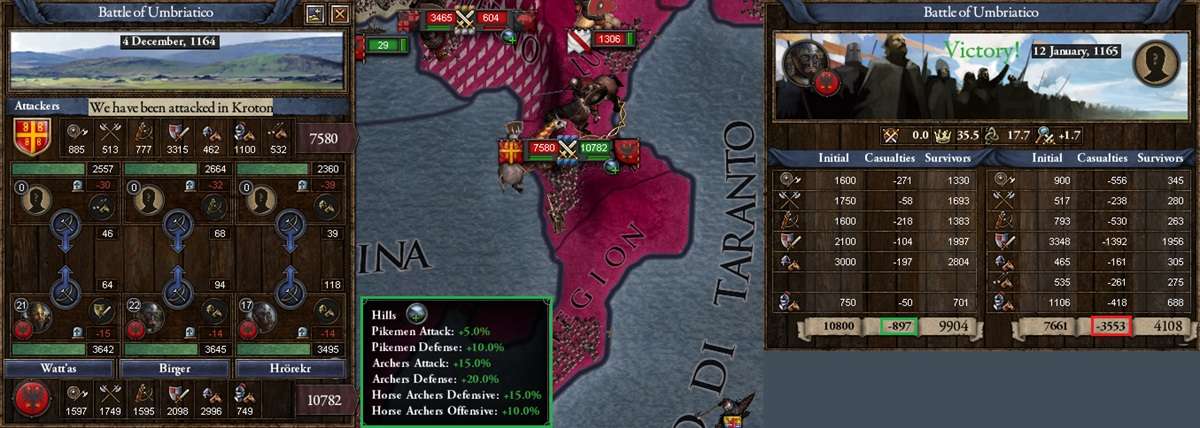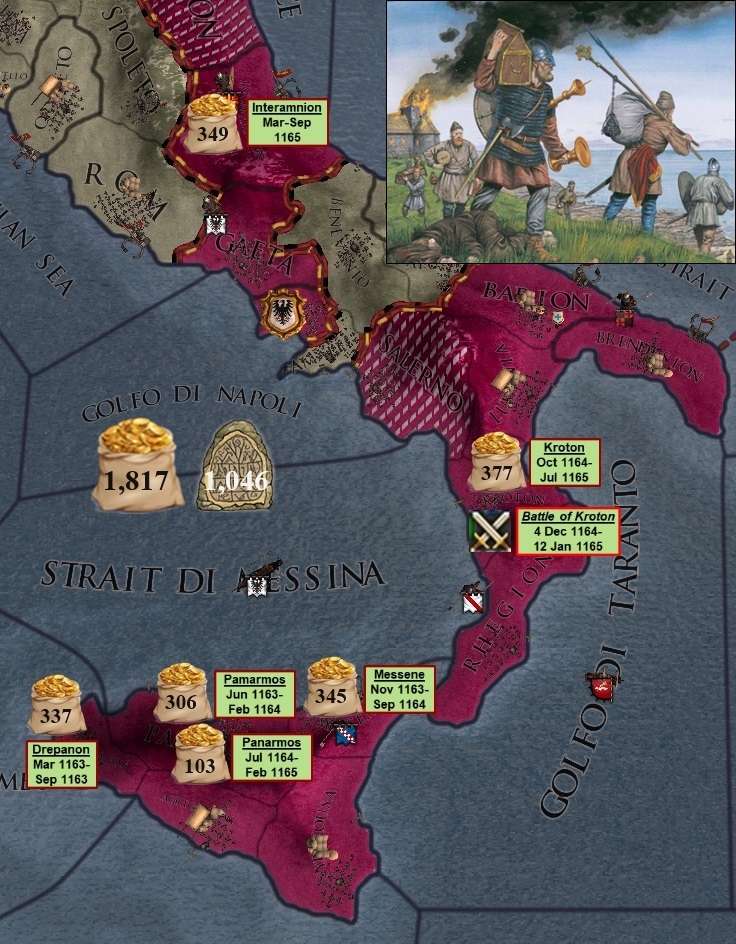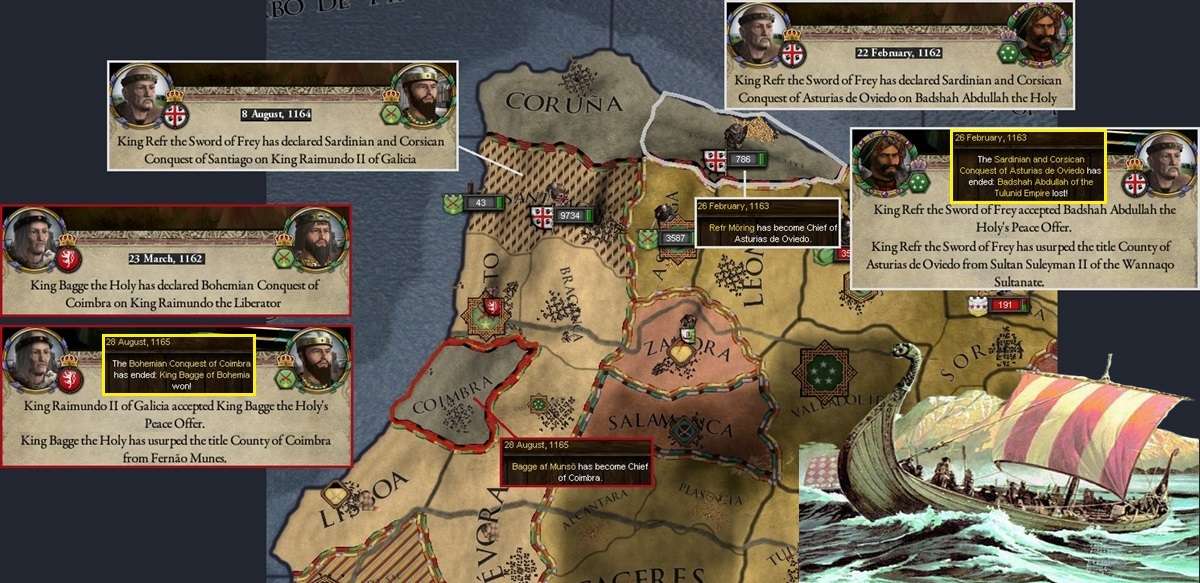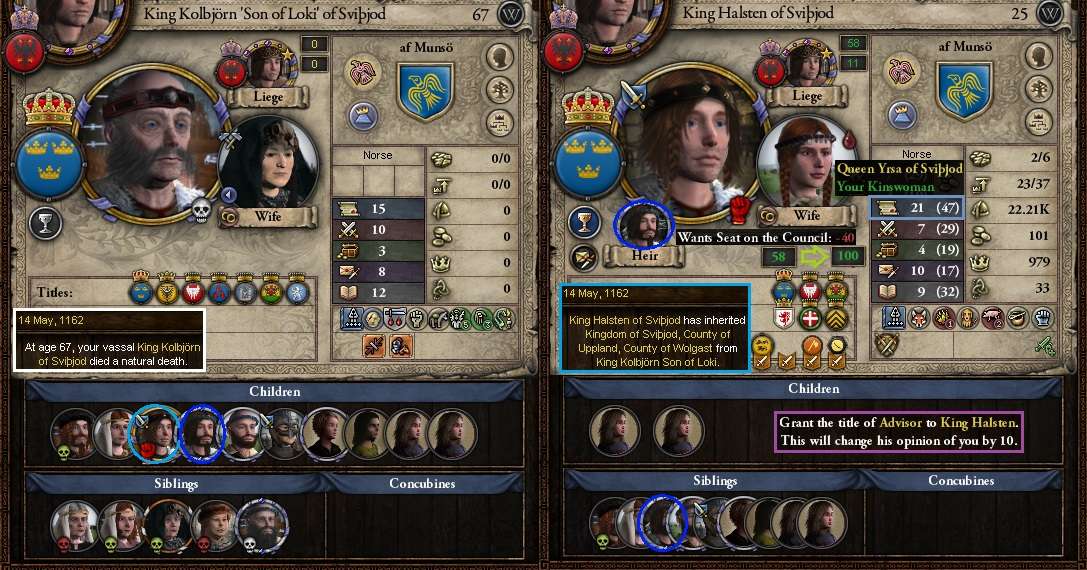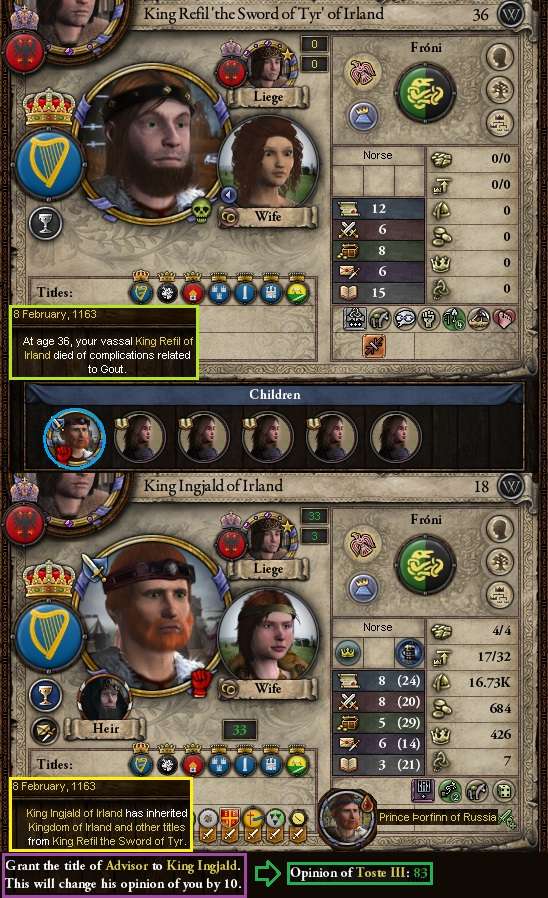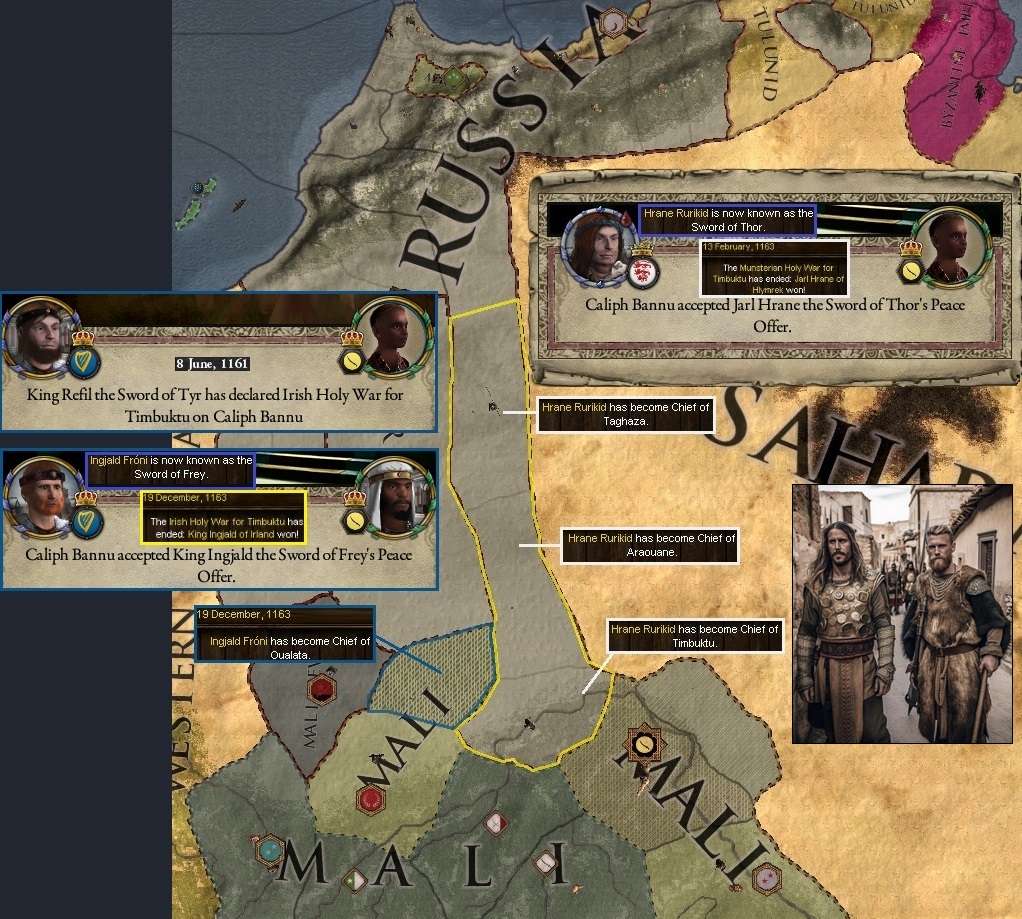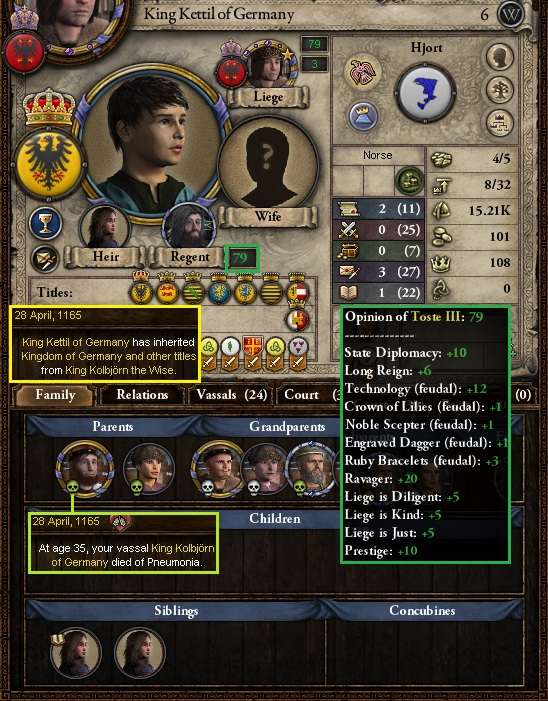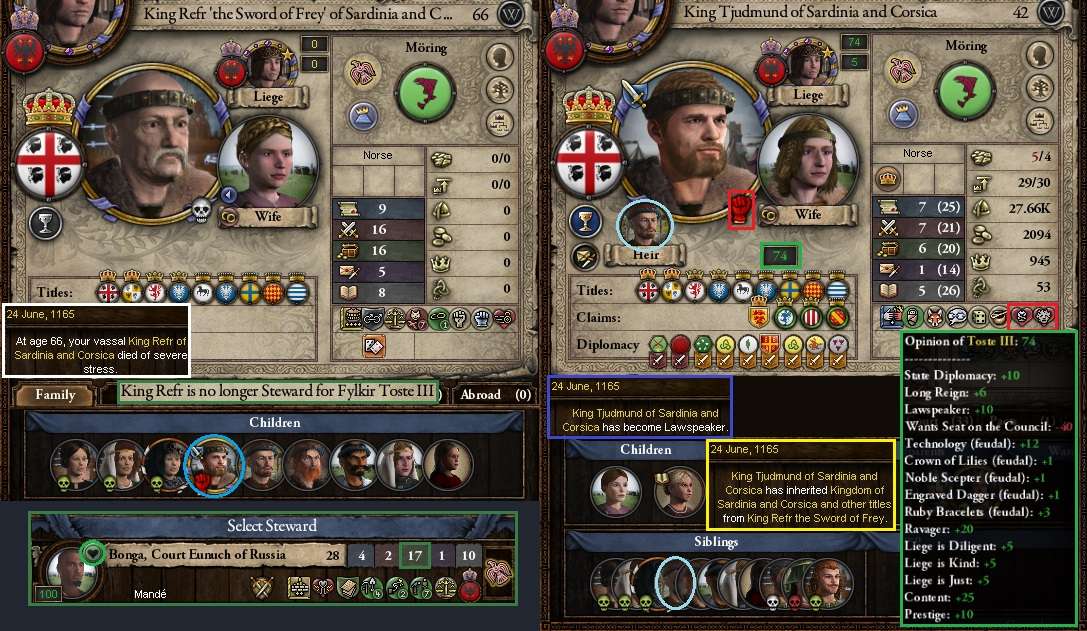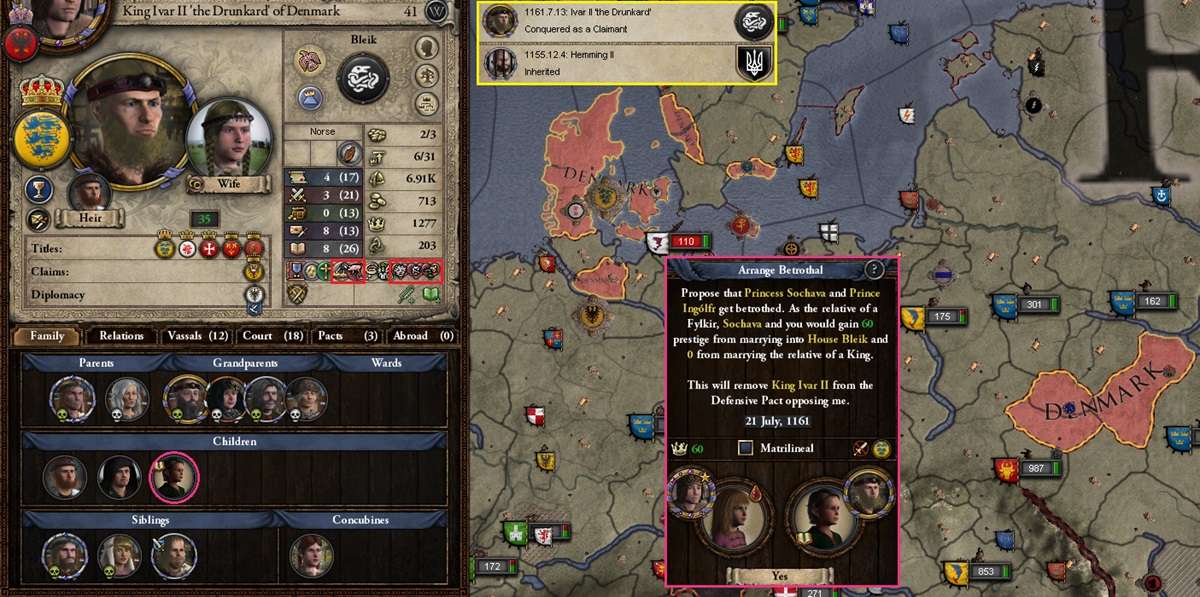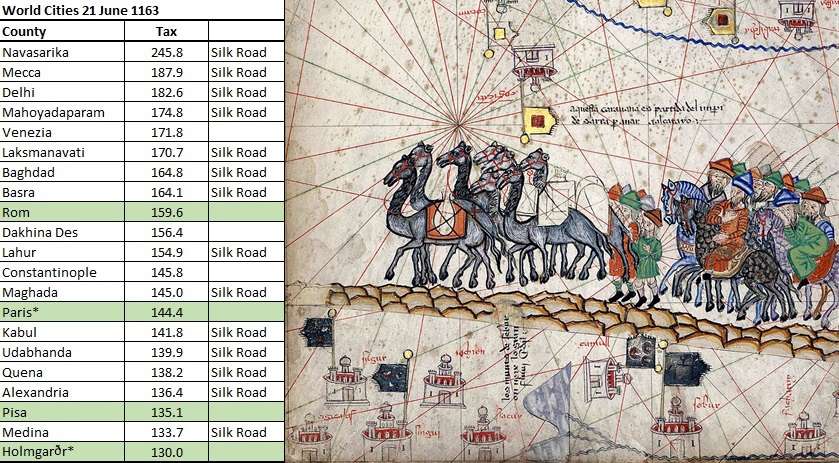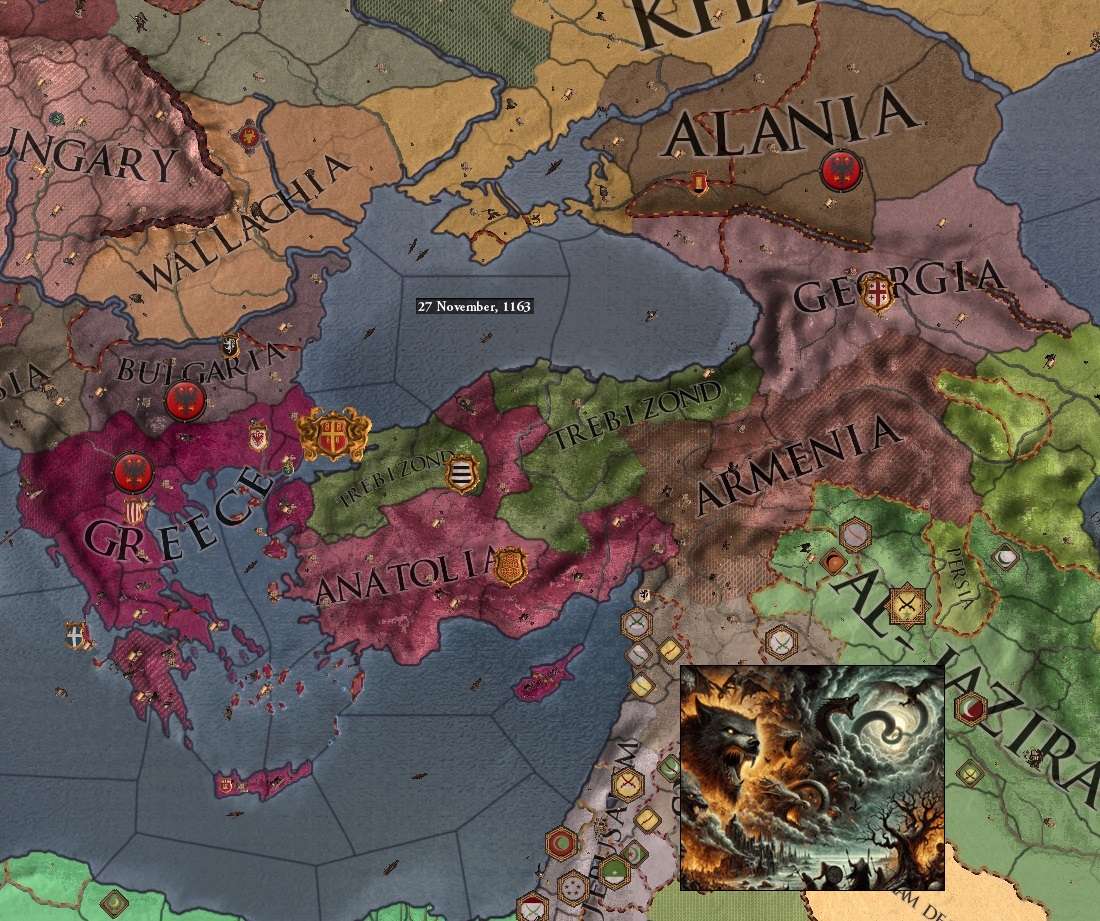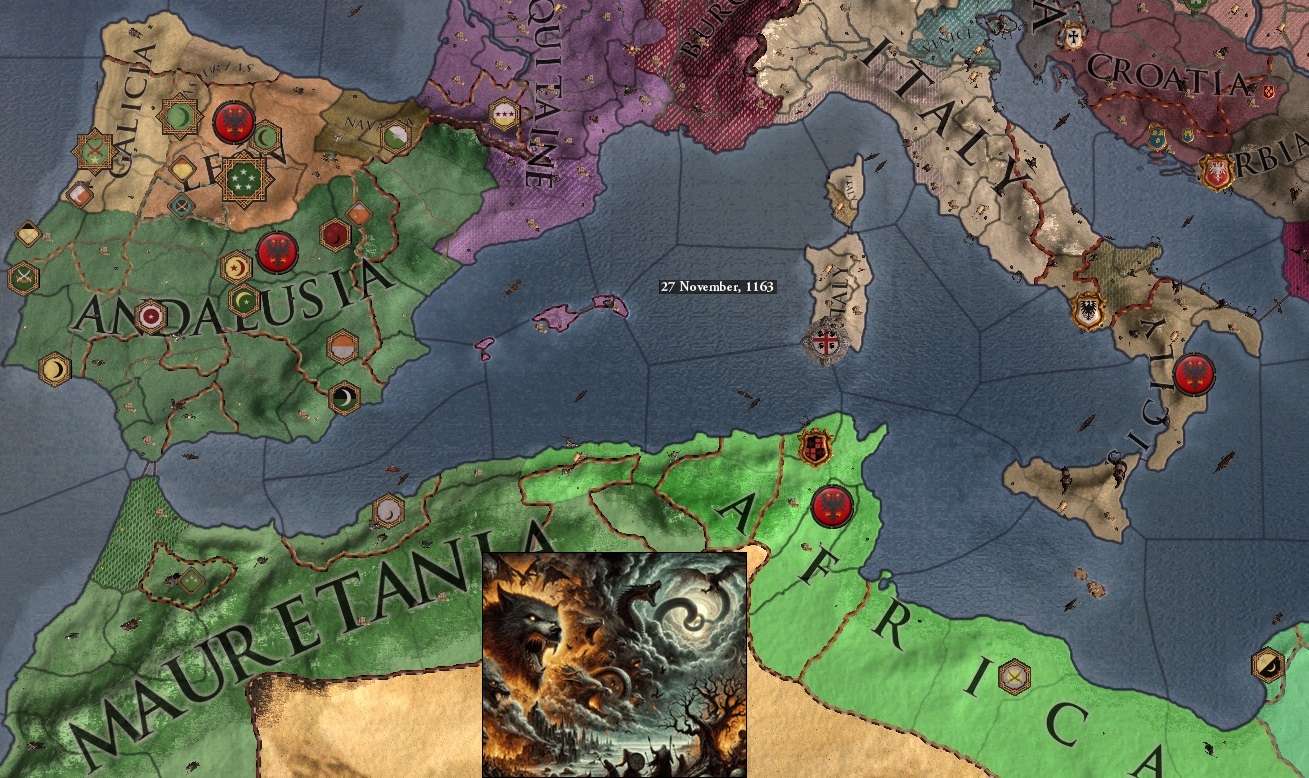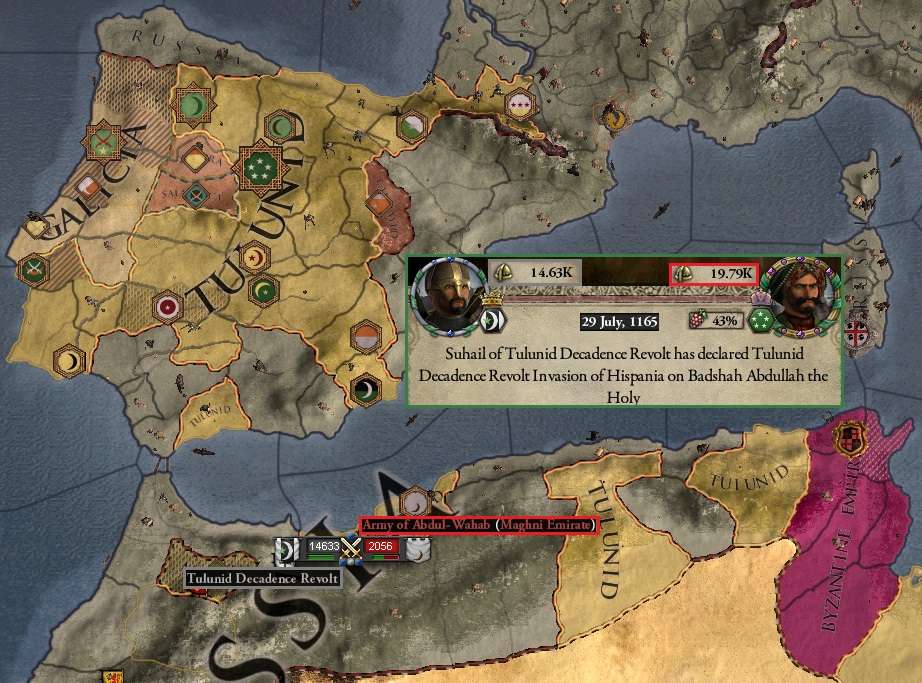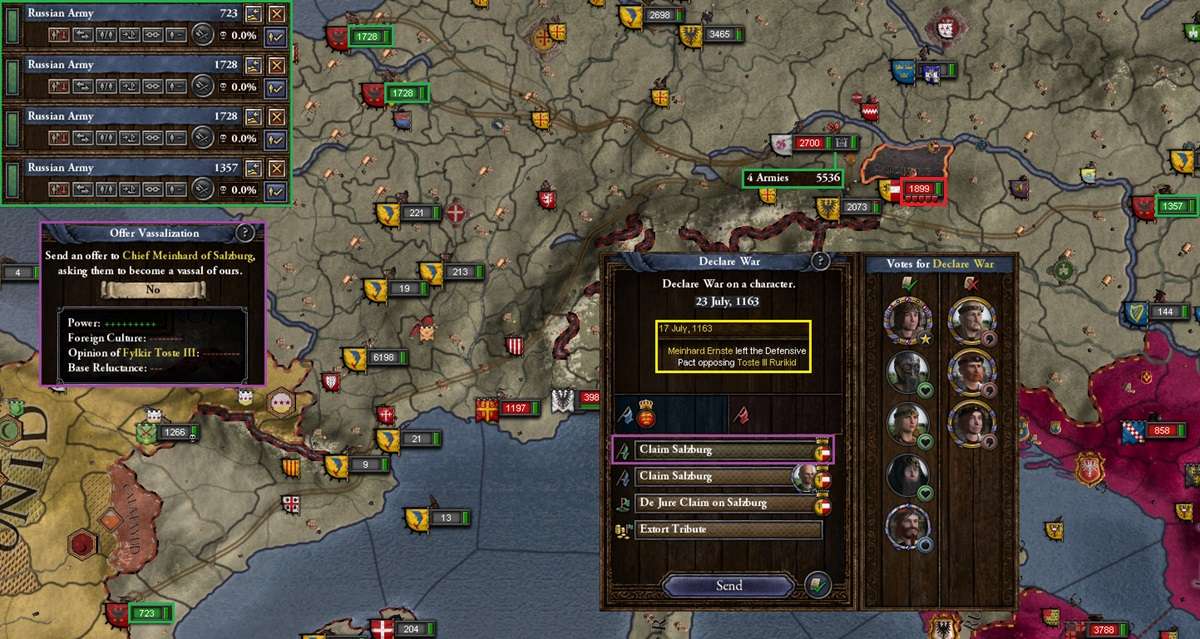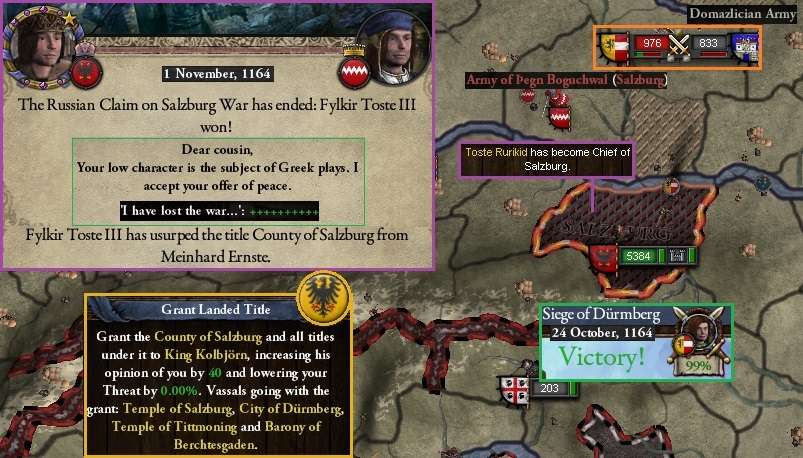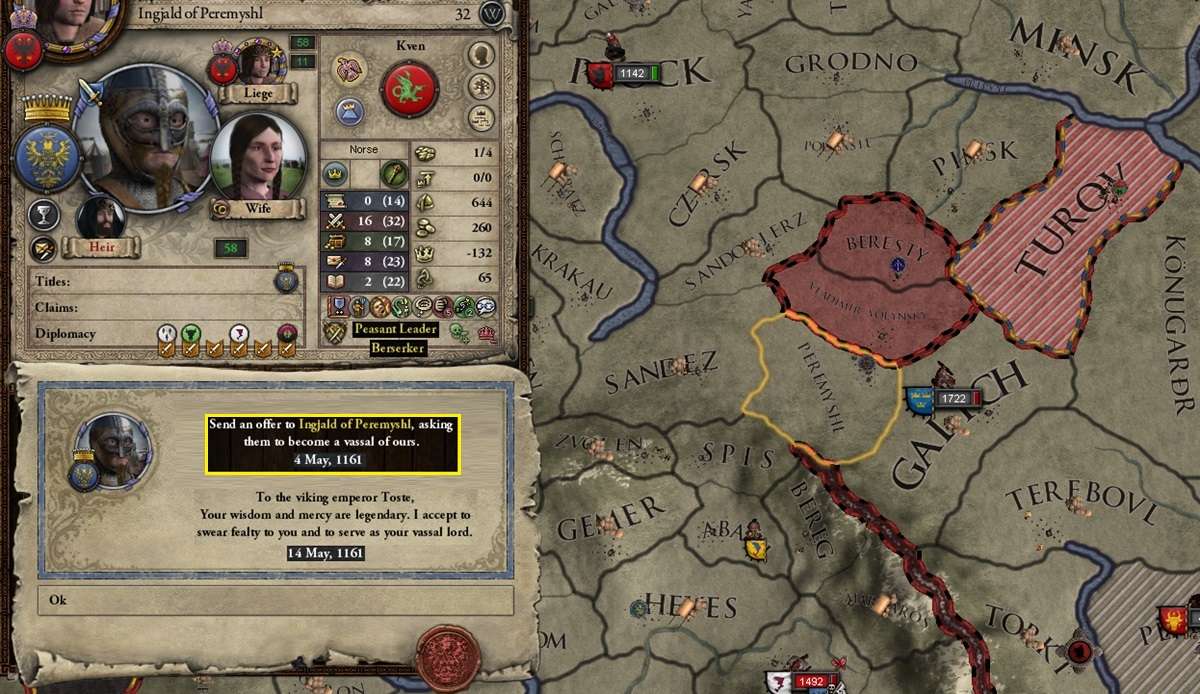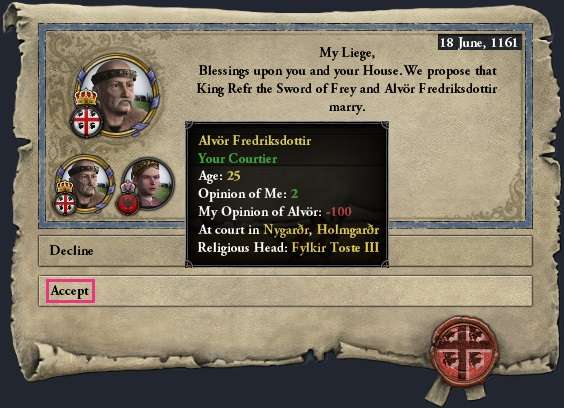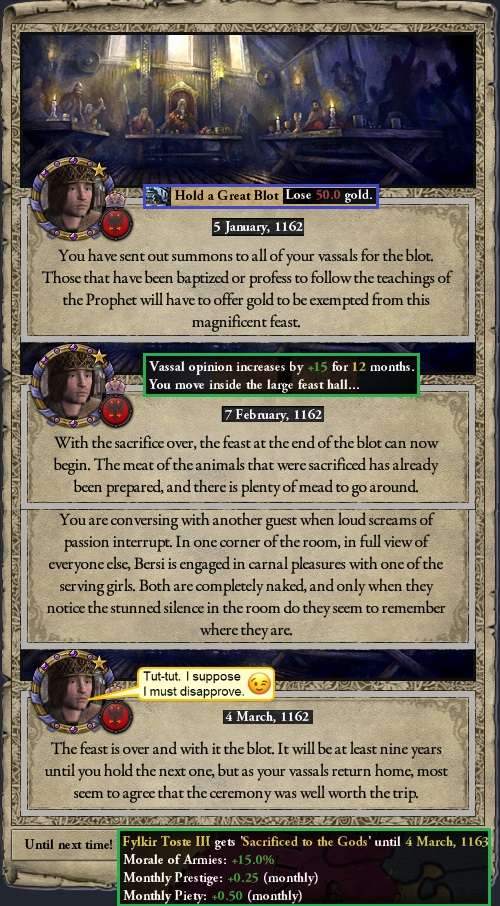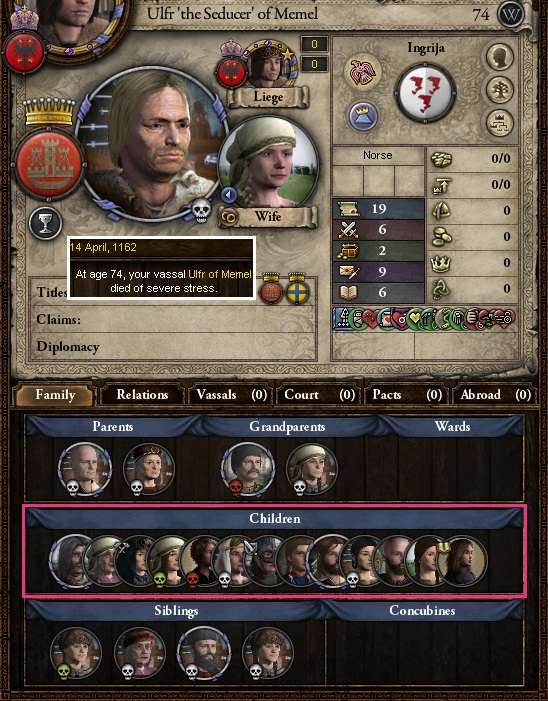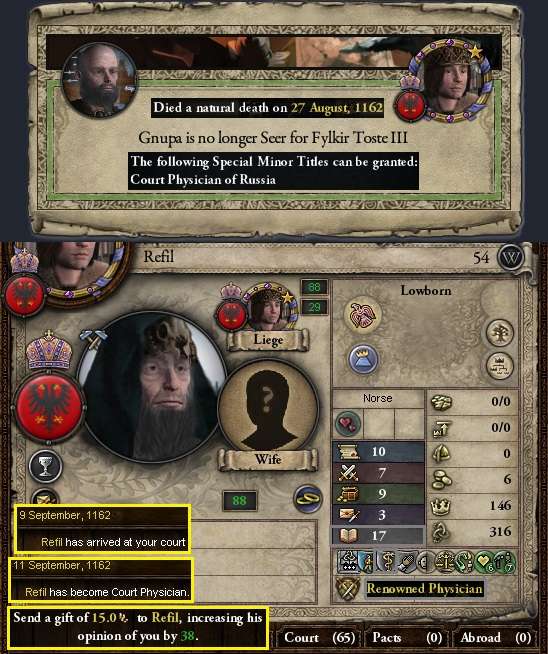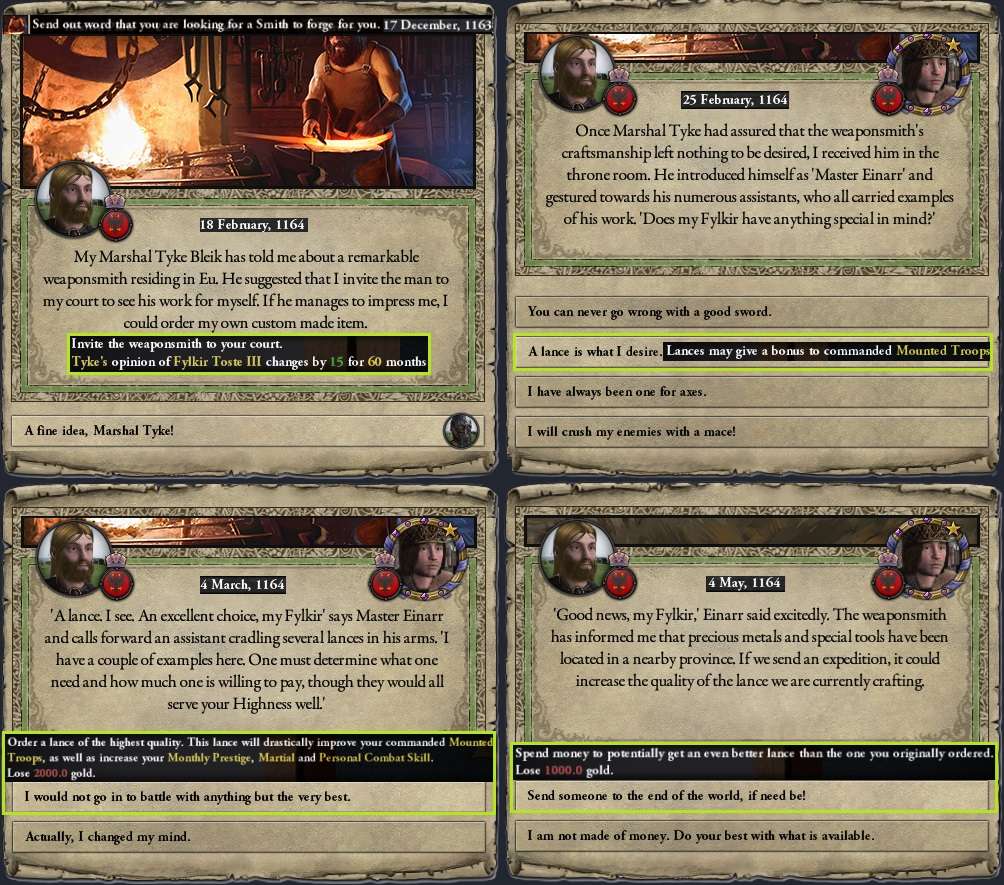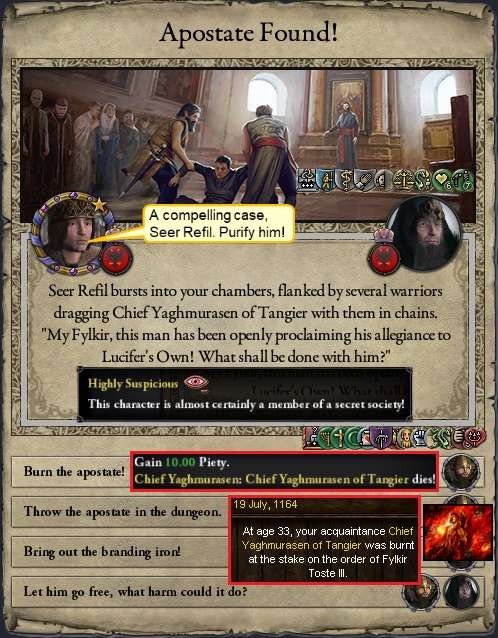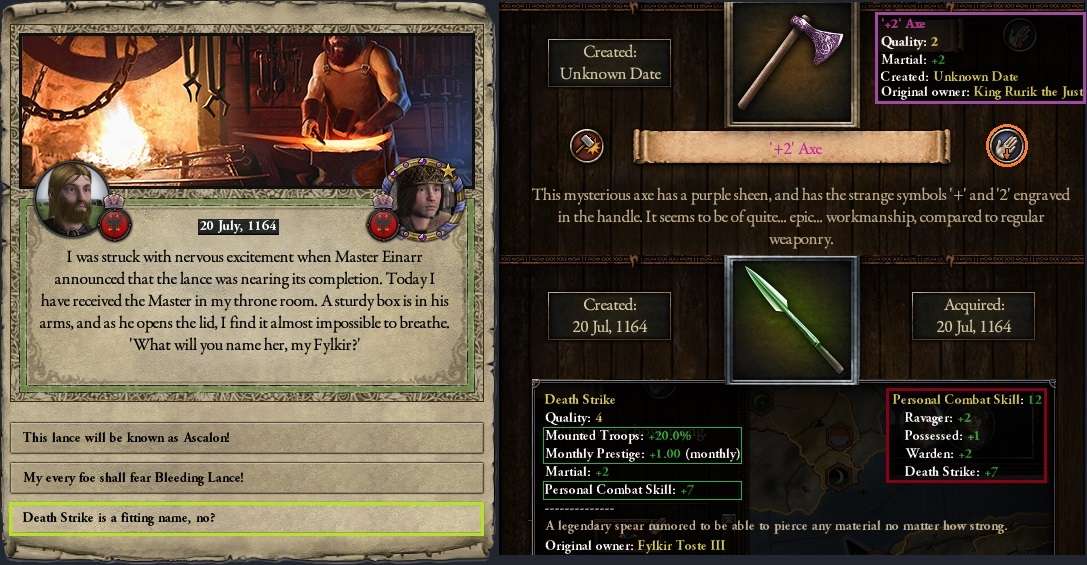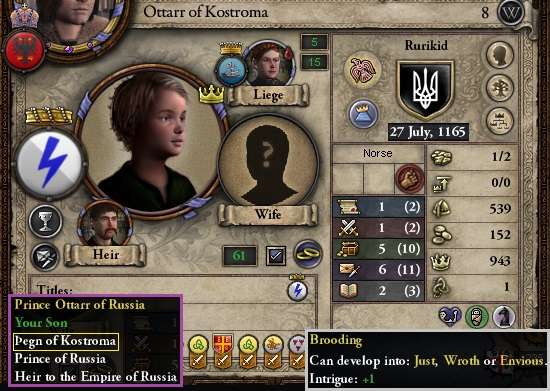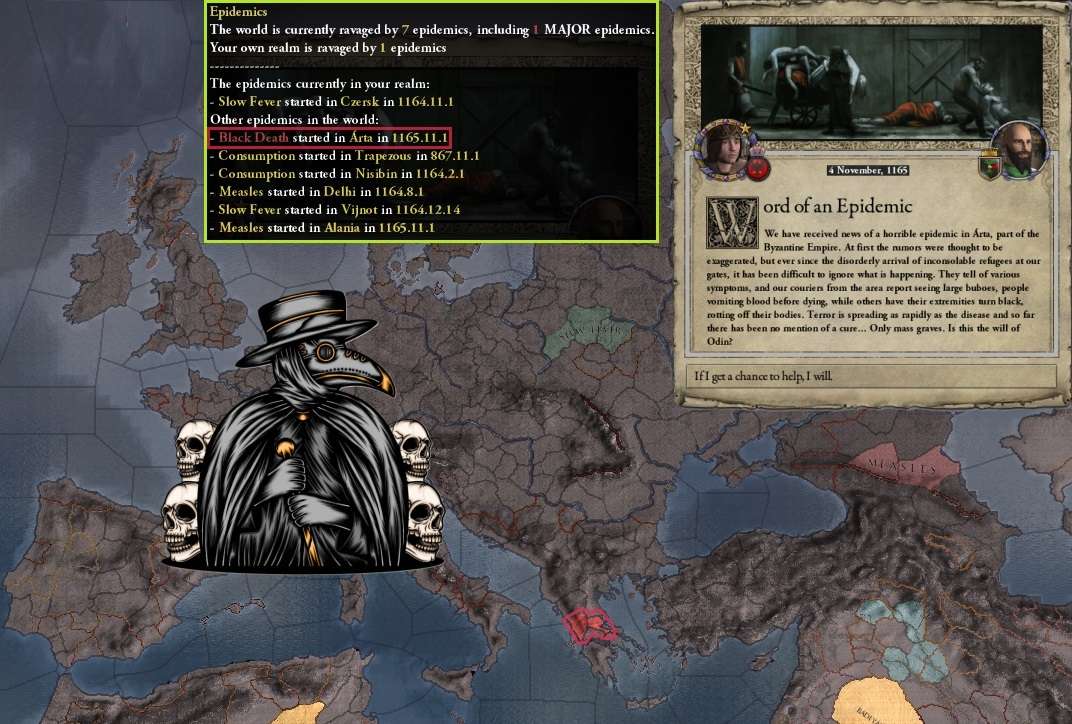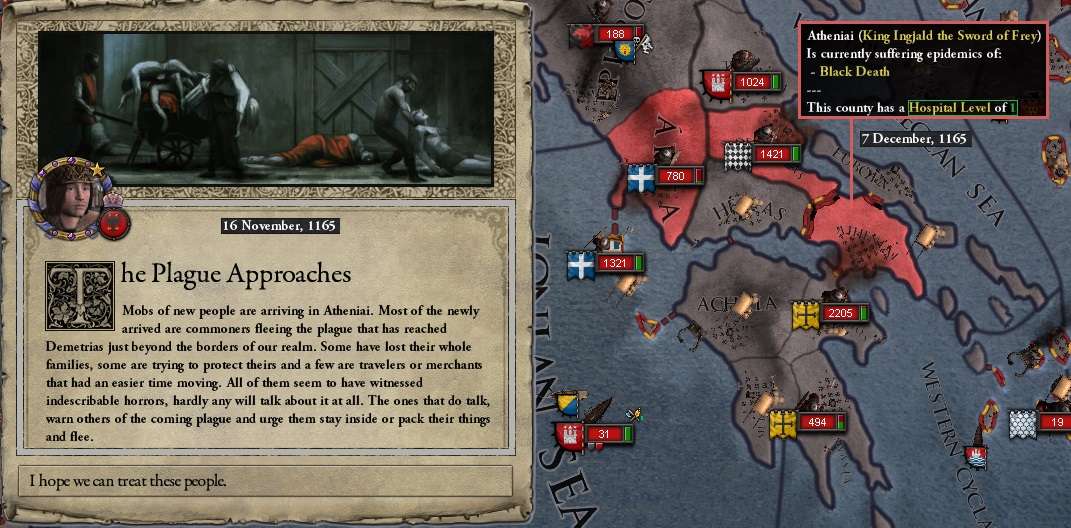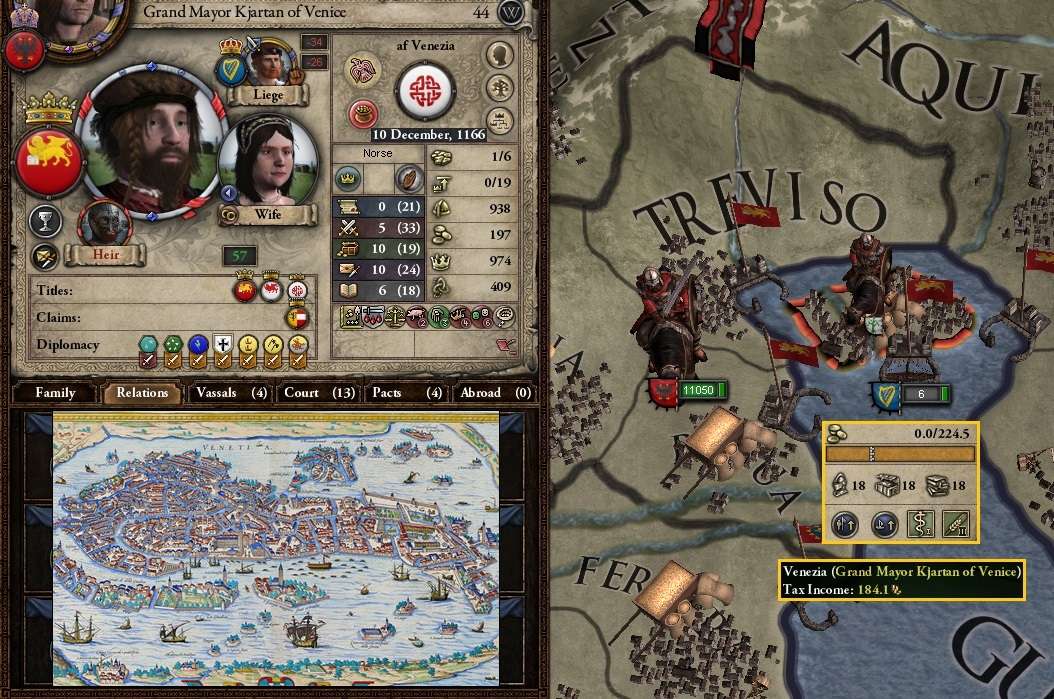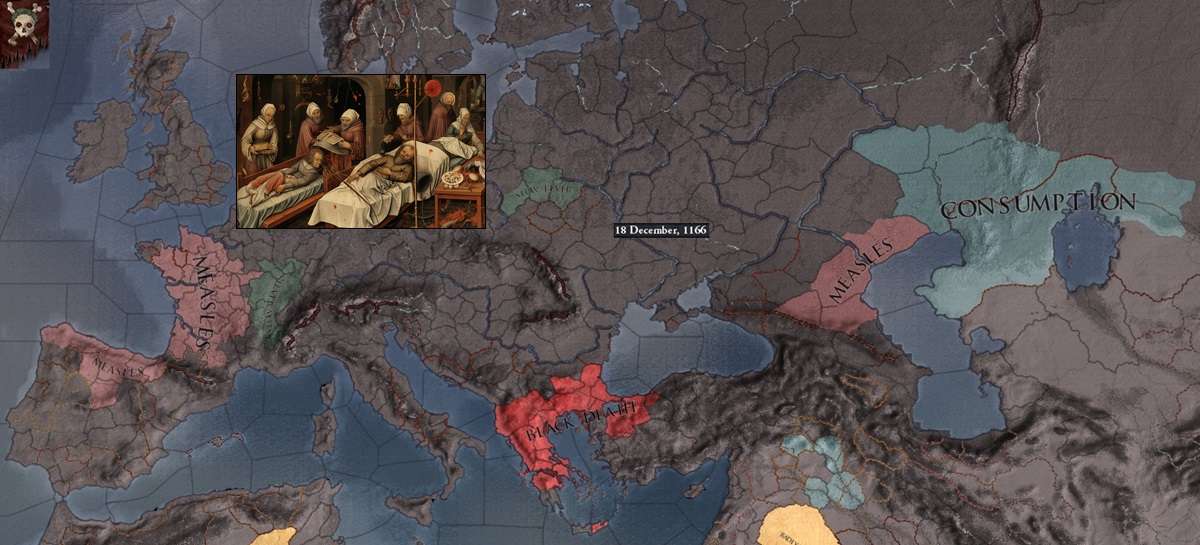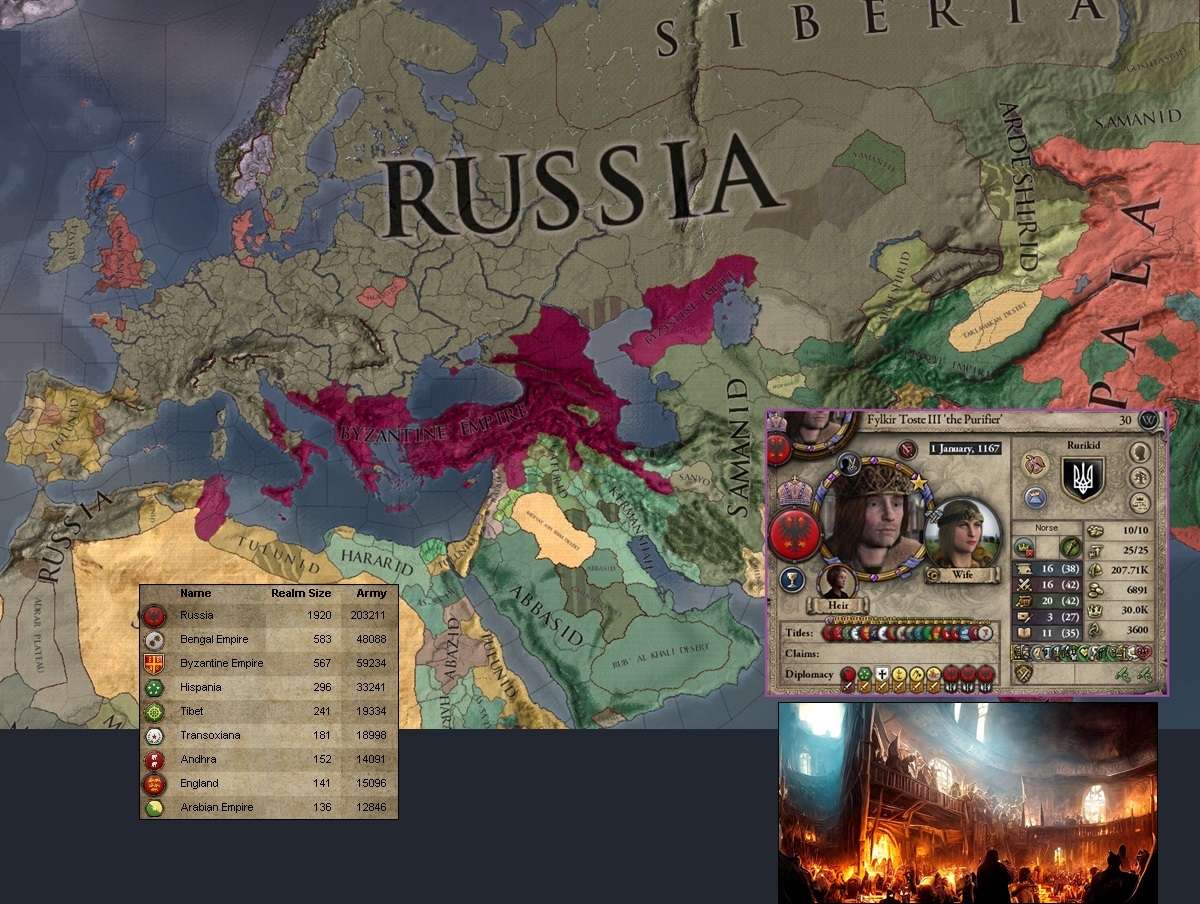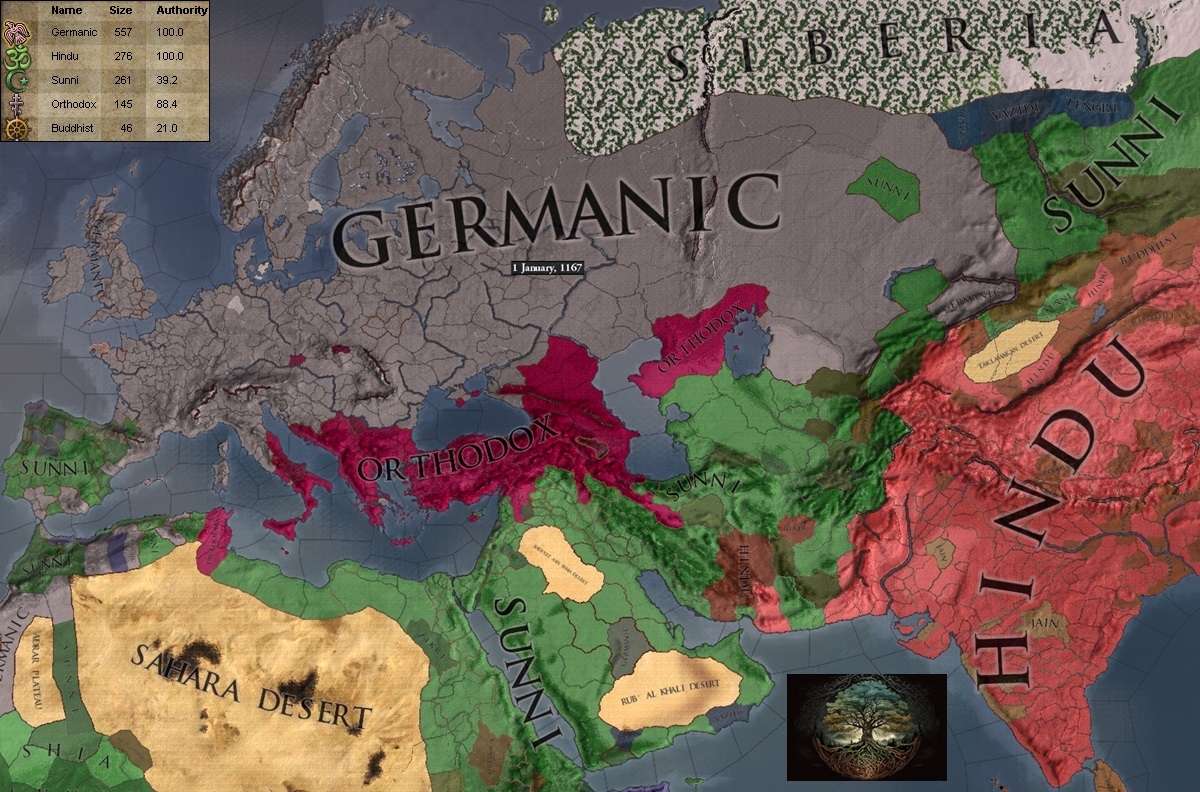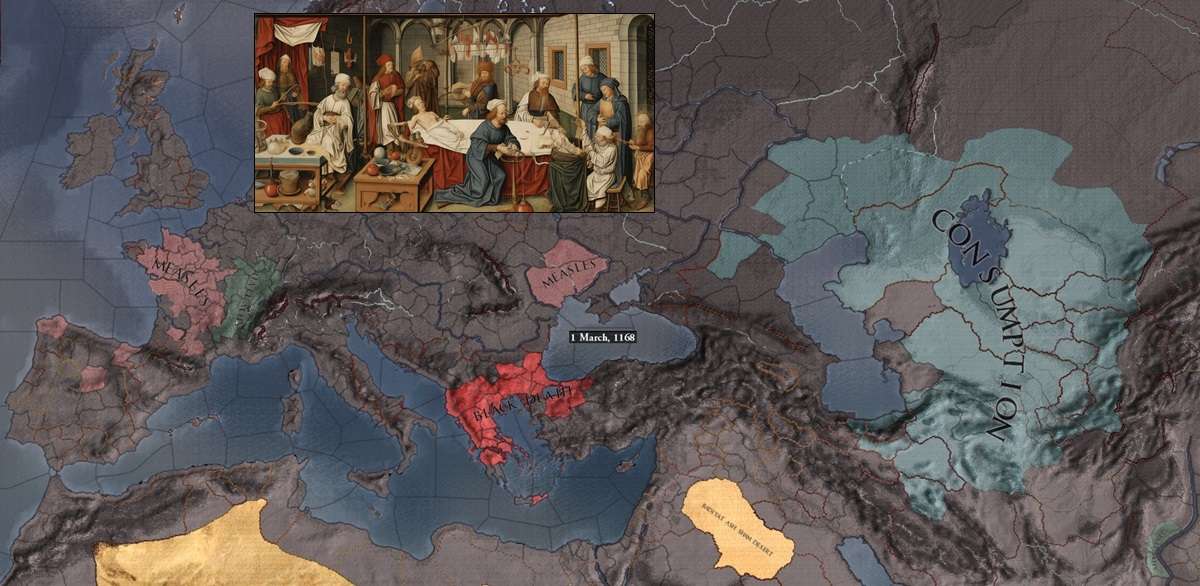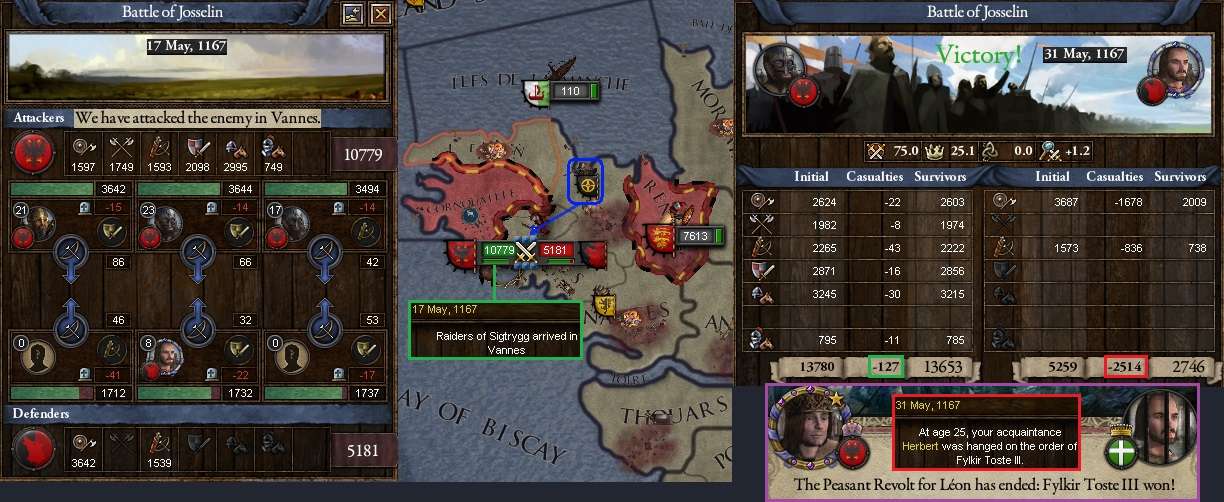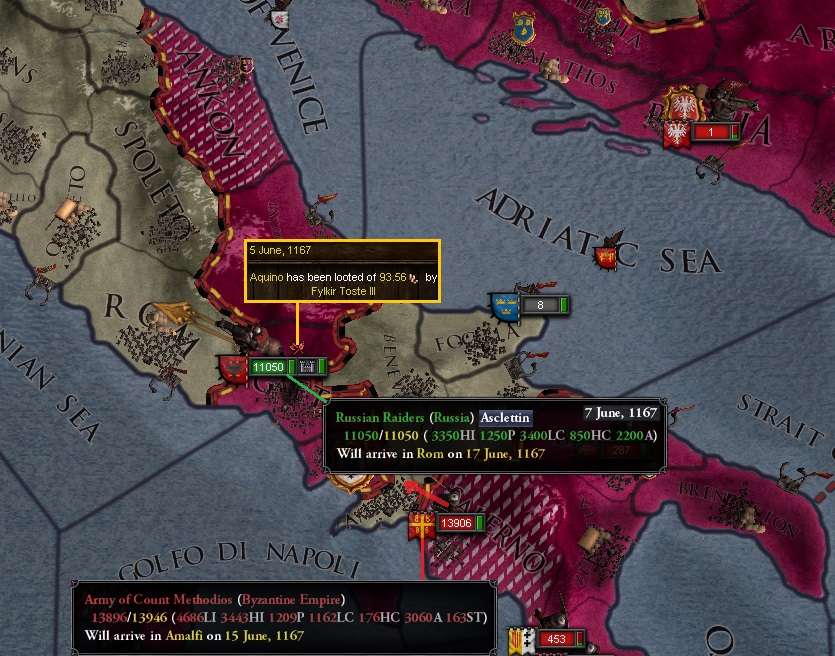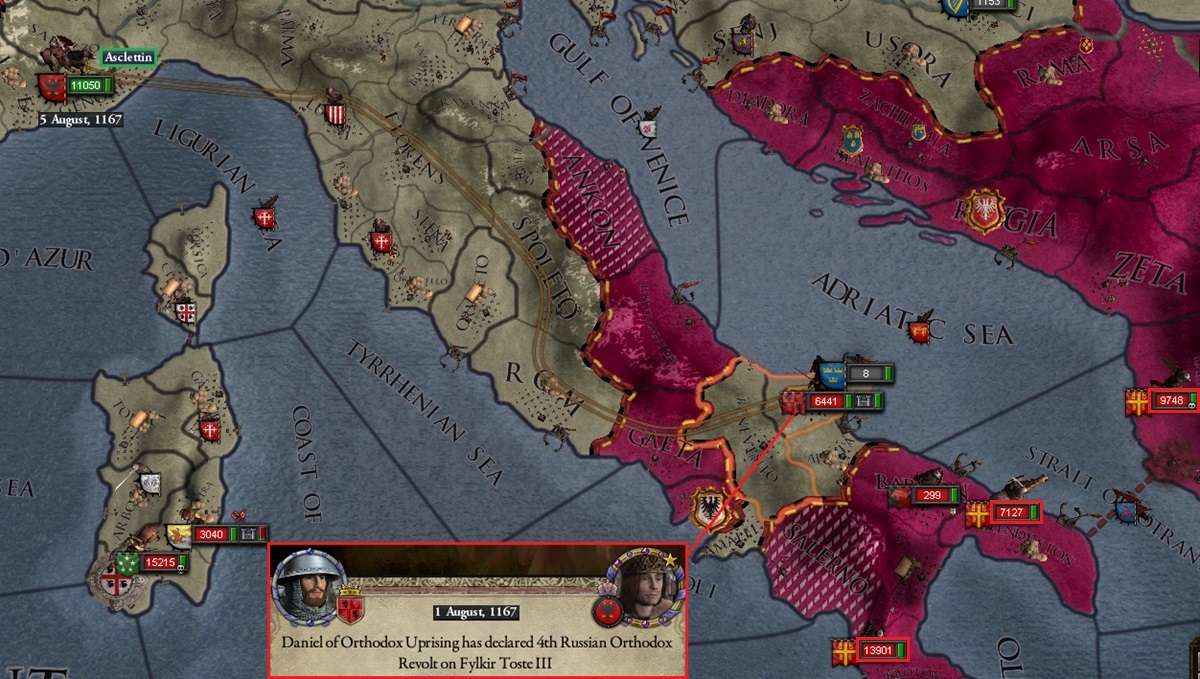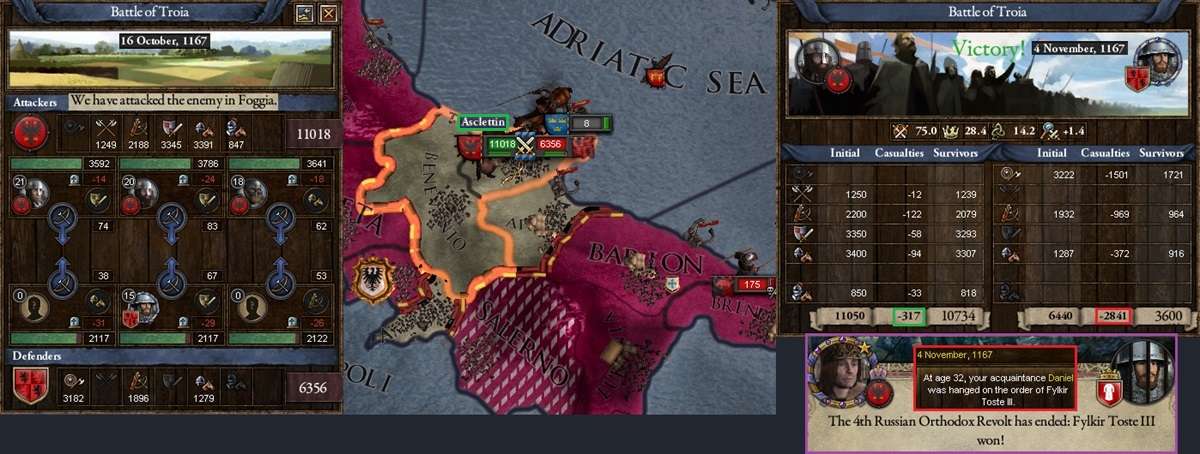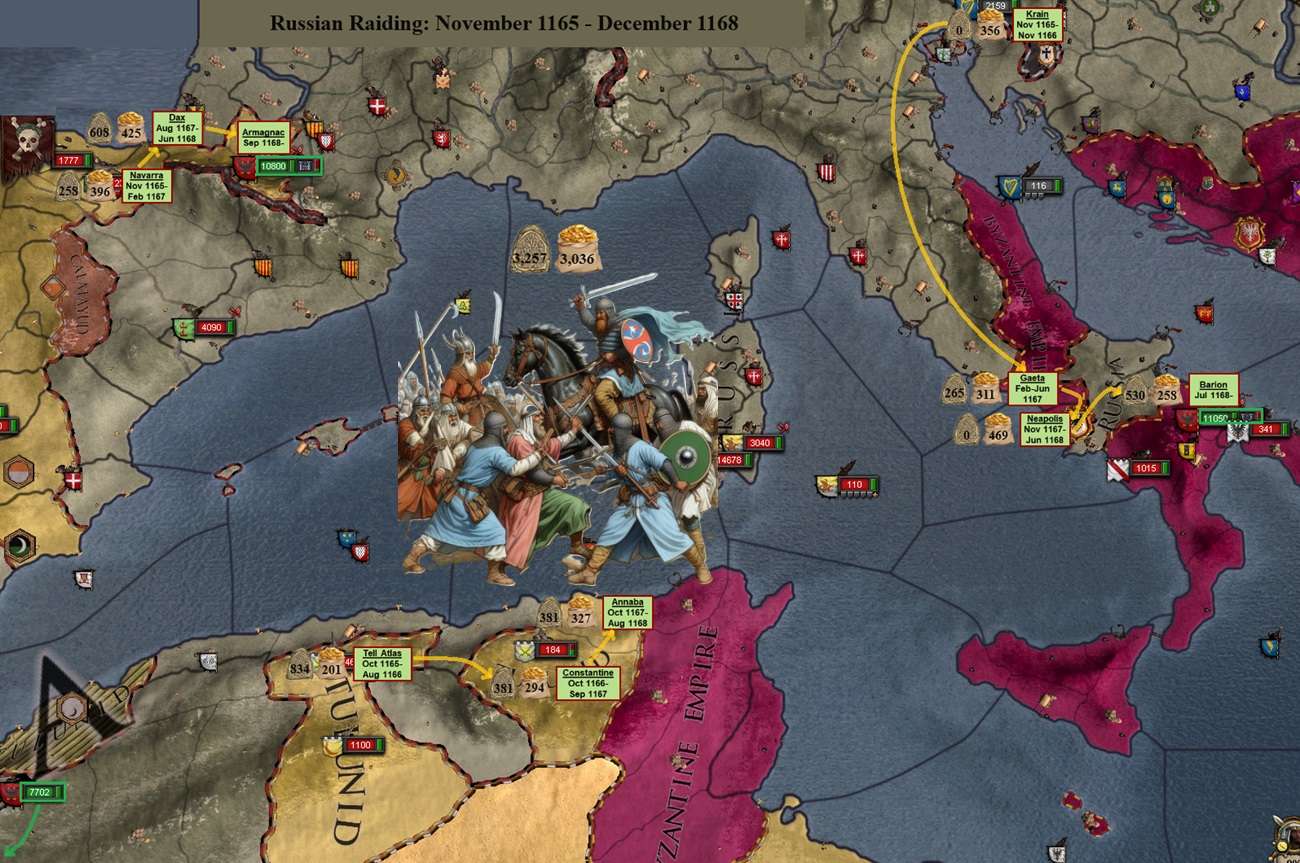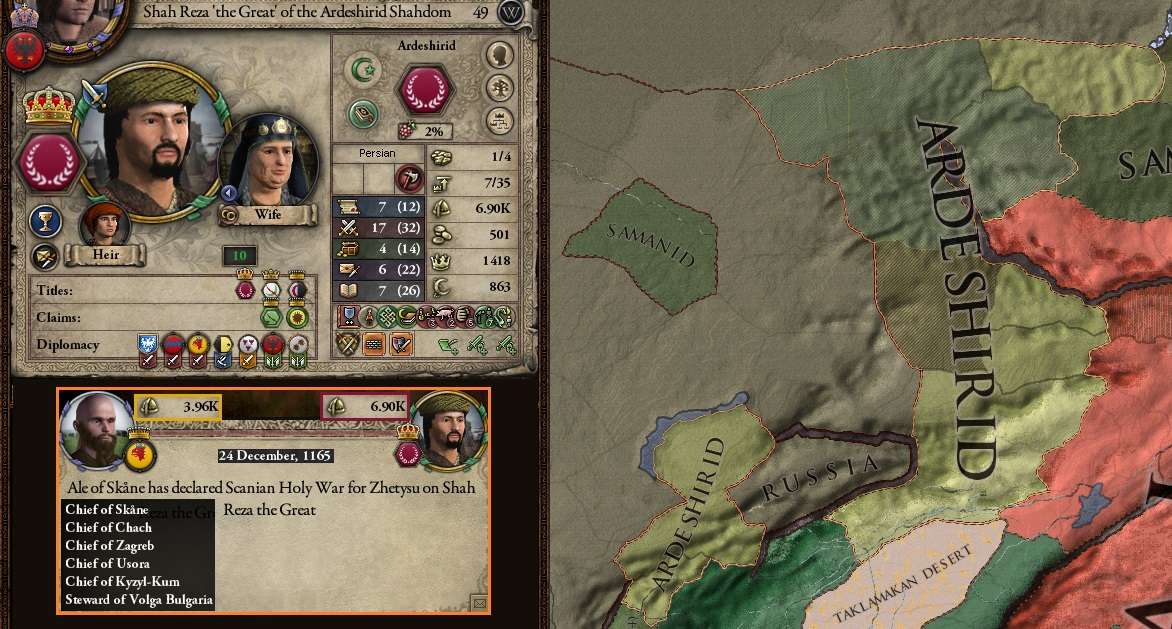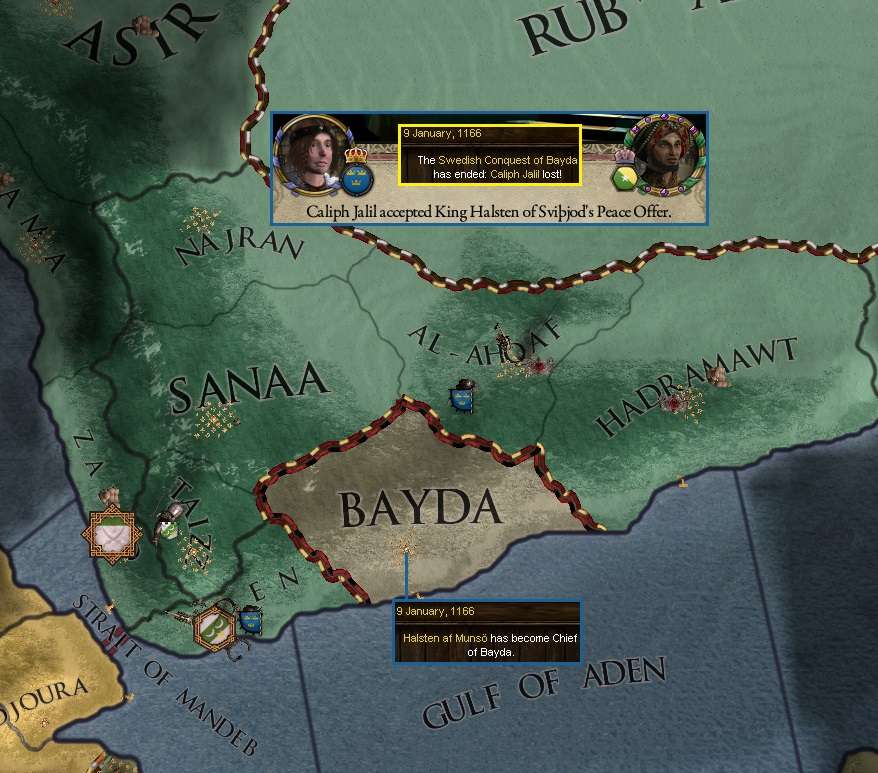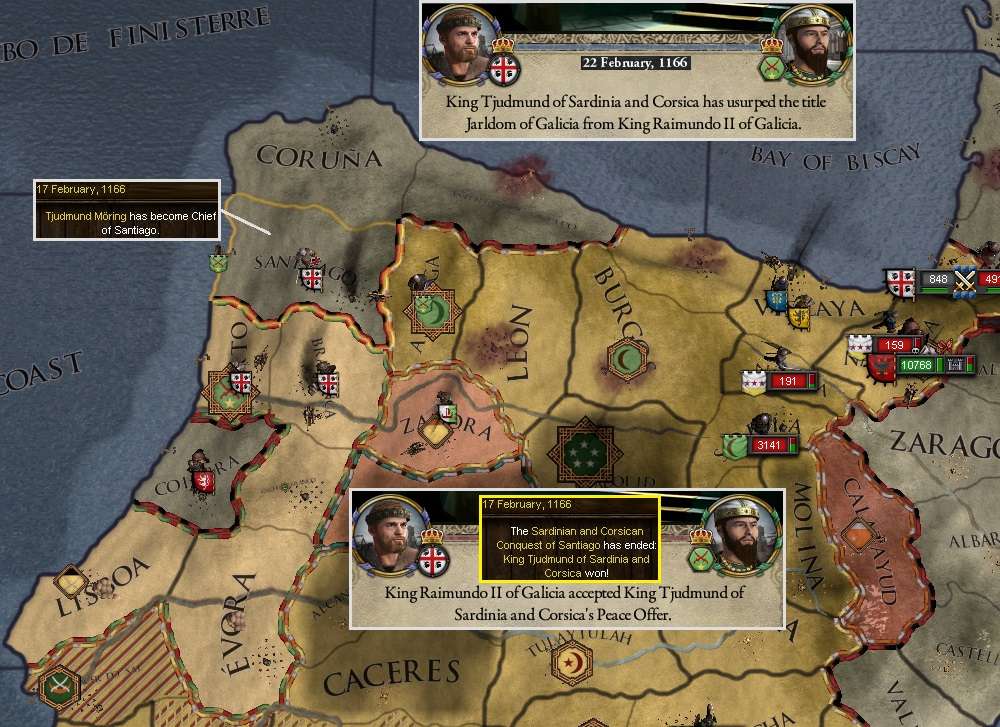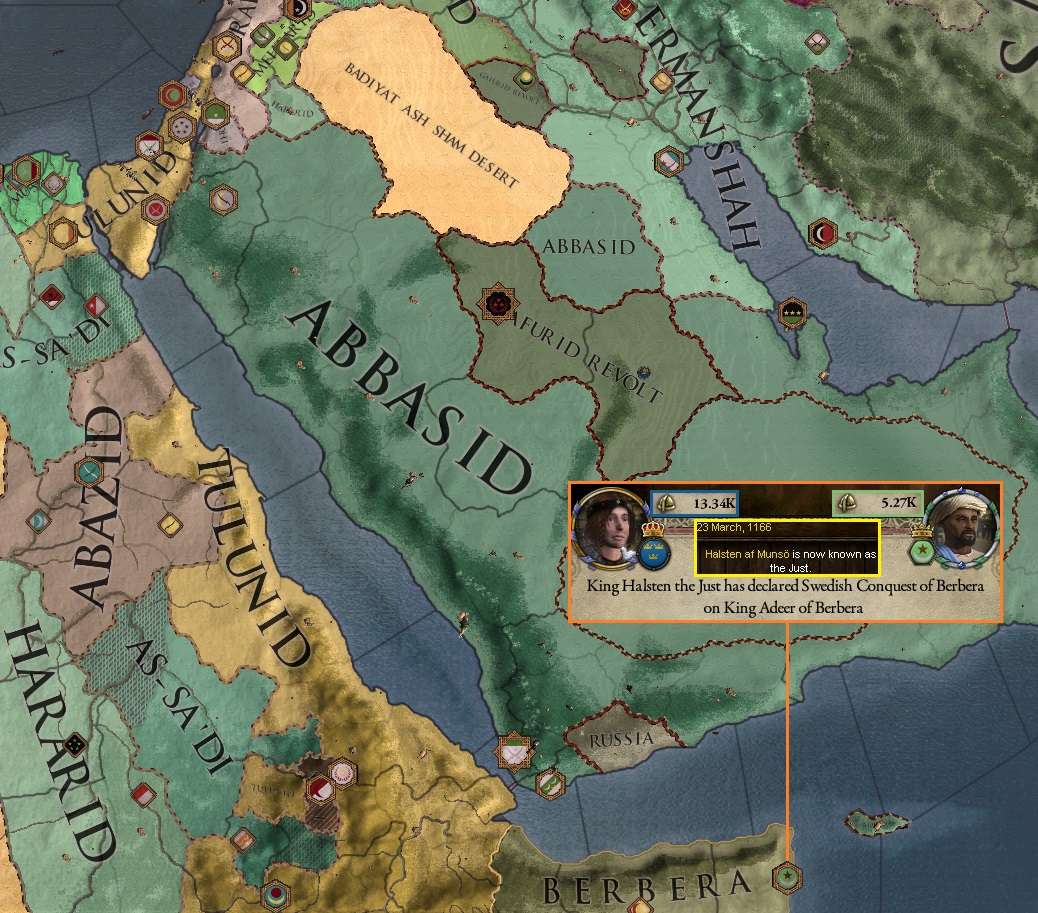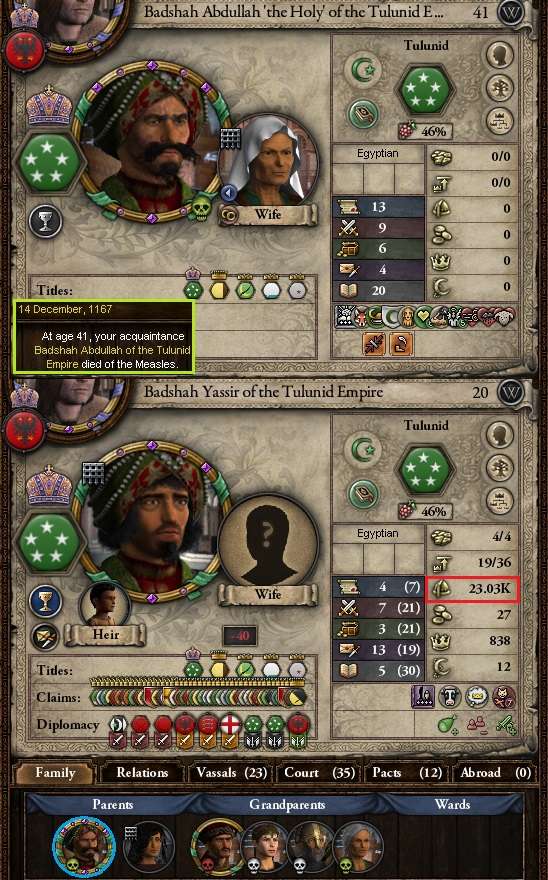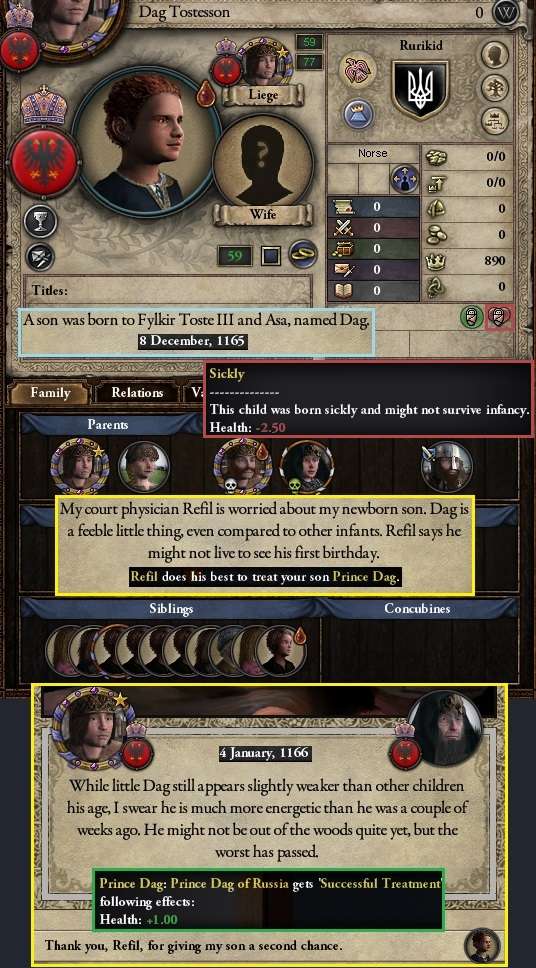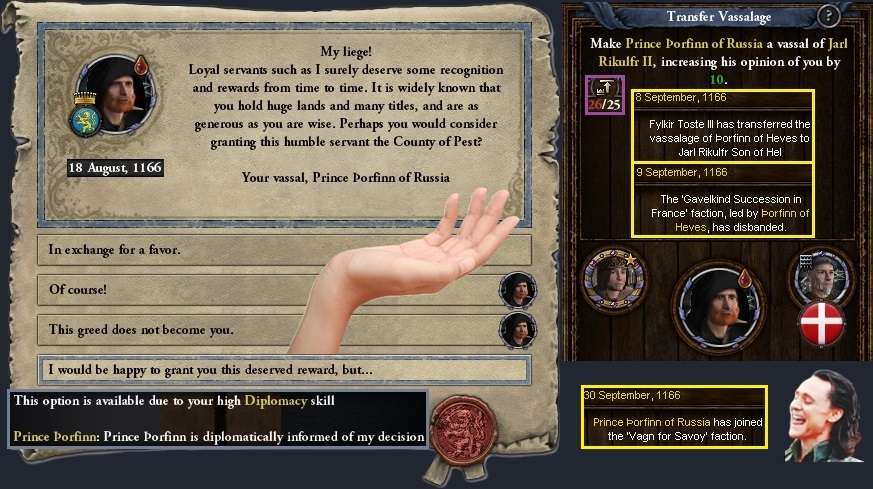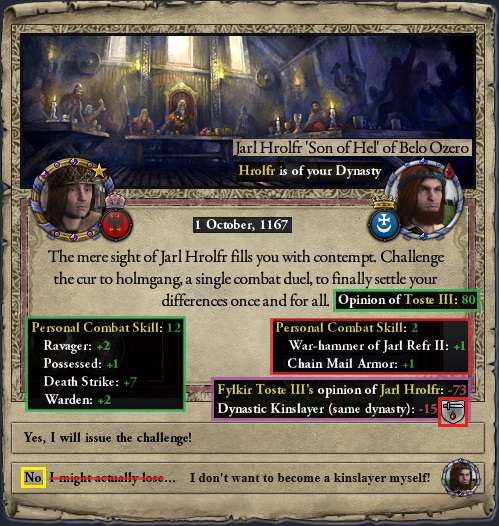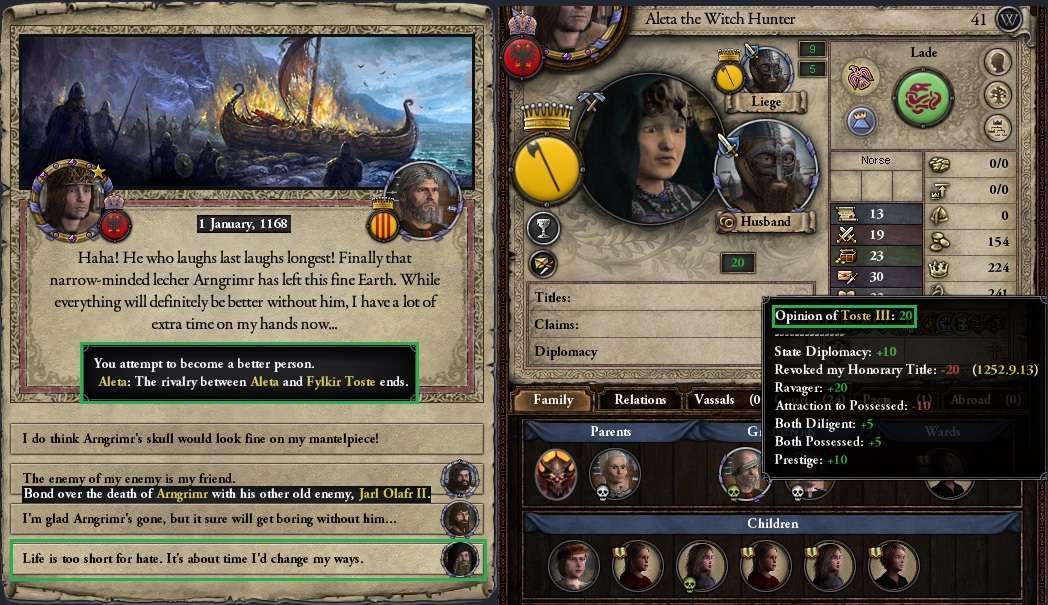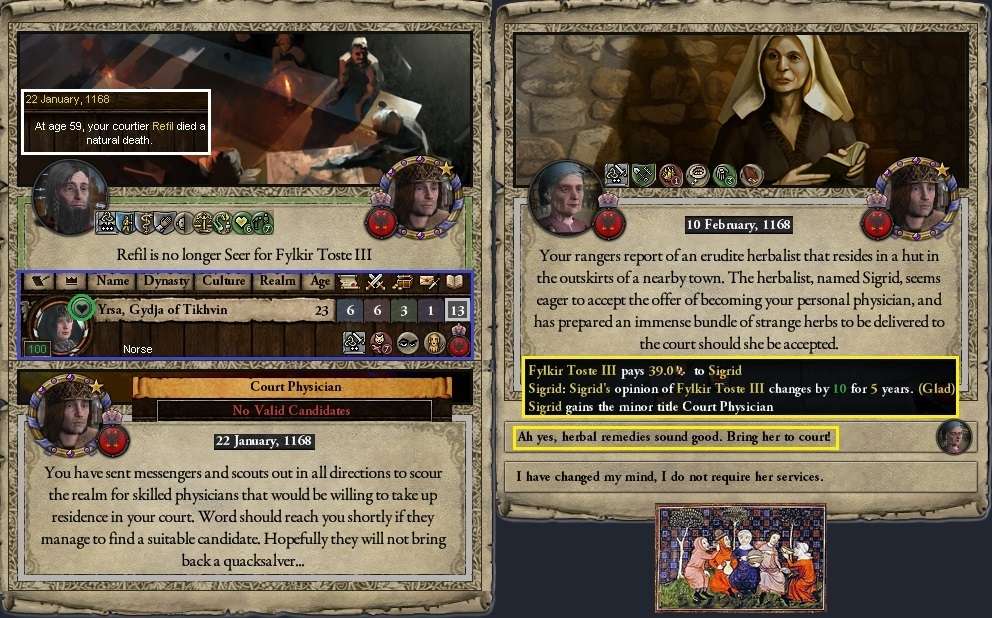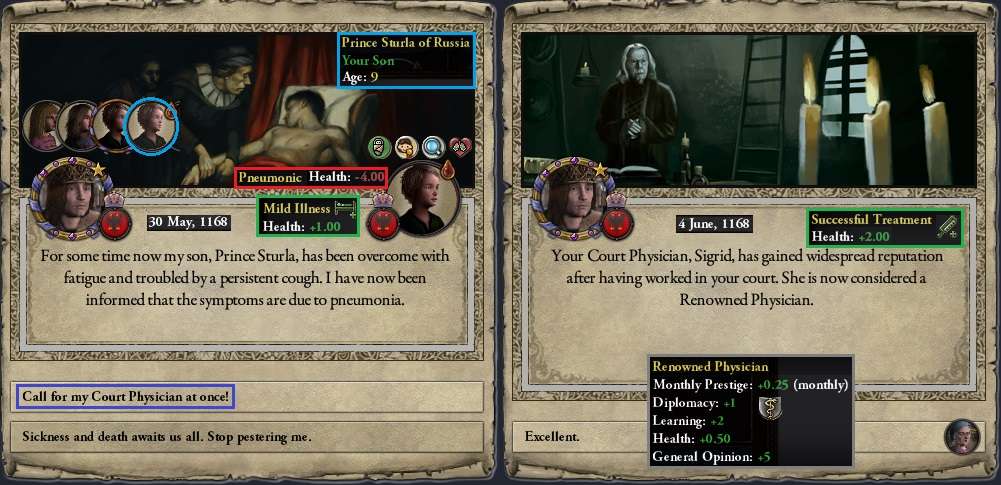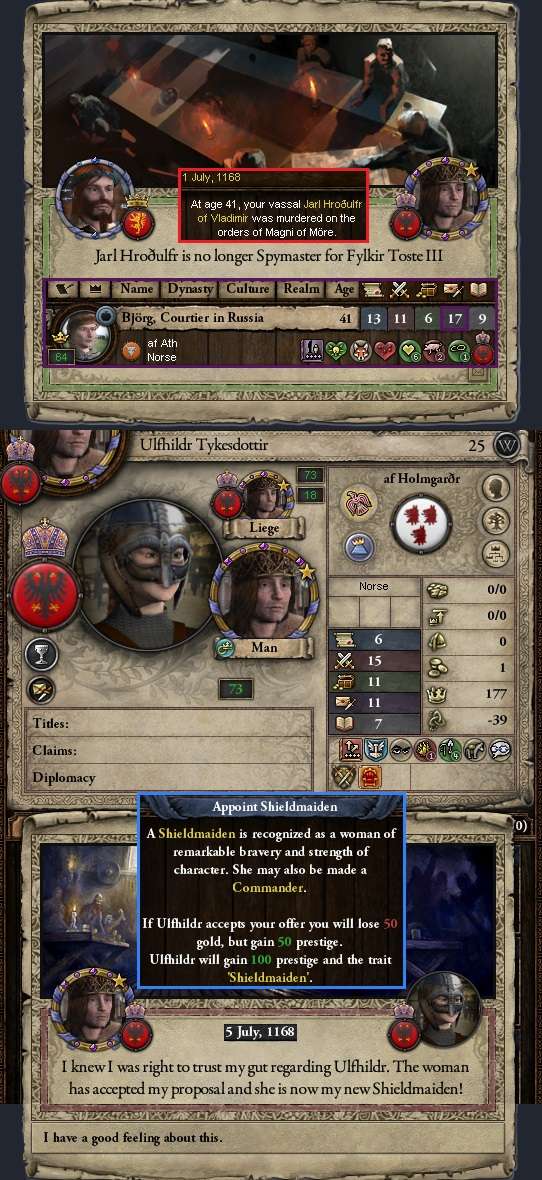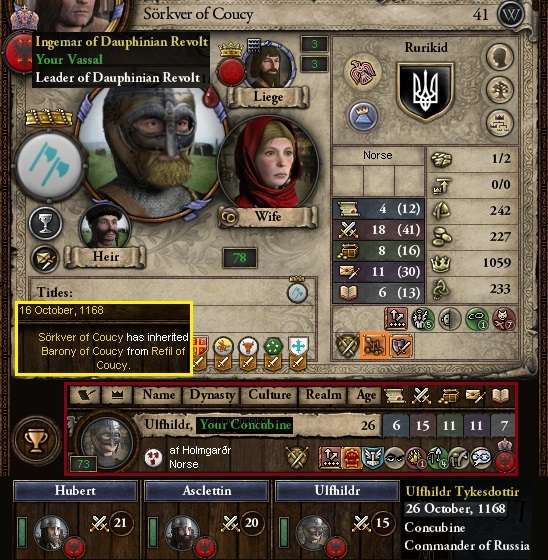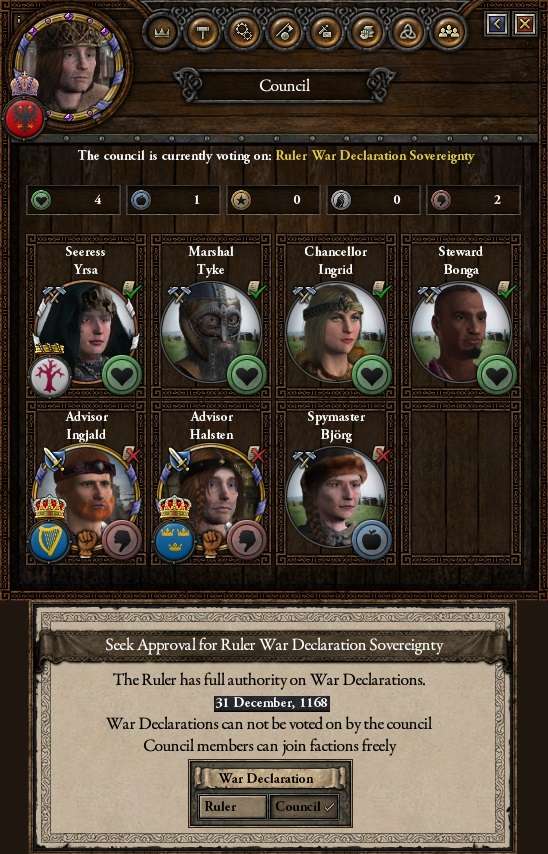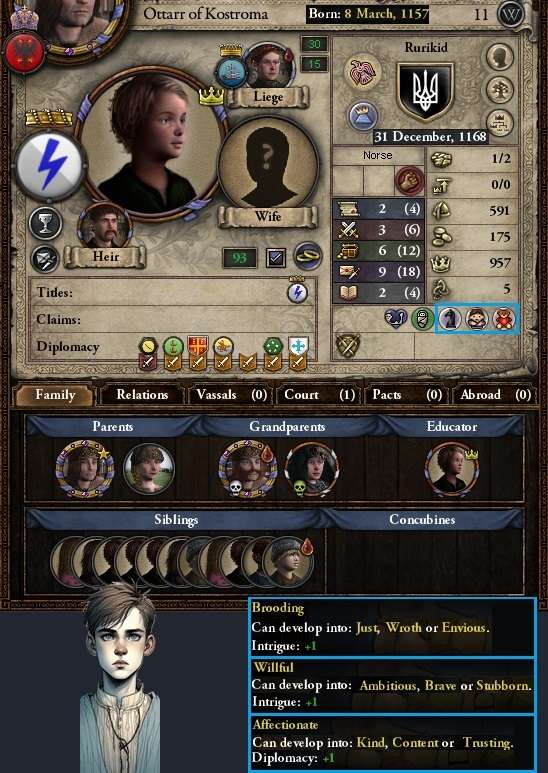Chapter 54: A Dark Horseman (1161-65)
ᚔ ᚱᚢᚱᛁᚲᛁᛞ ᚔ
After the Jihad
As the Jihad ended in early May 1161, four Russian armies totalling over 38,000 Guard and levy troops needed to march from Arabia back the boats docked off Palestine. For some, more attrition in transit would be suffered along the way. They would not all be fully embarked and heading back west until mid-July.
The army in Tabiristan started with 12,000 men as the war ended and it would take over six months to eventually make it back to Abkhazia on the Black Sea via the Caucasus, with only around 8,000 levies left to be sent back to their homes in mid-November, while the Young Guard remainder of about 1,400 were called back to Holmgarðr.
On 17 May, after the North African army levies had been sent home once on Russian territory, the two remaining forces – a larger Guard army (10,800) and the remaining Jomsvikings (down to around 4,250) performed their Raiding Toggle ceremonies and headed to their raiding grounds. The Jomsvikings west to Fes, the Guard army east towards Byzantine Tunis.
As these redeployments were being made, Ravenna was again troubled by a peasant revolt. The fleet returning from Palestine was just off the toe of Italy at the time, so was diverted up the Adriatic to deal with the scum. They would arrive in Ferrara on 4 August, with levies and one of the large vassal fleets (from King Refr of Sardinia and Corsica) sent home and the remaining 8,000 Guard troops under General Birger recuperated from their voyage before they would strike the rebels.
The rebels were attacked and defeated in Ravenna from 15-30 October 1161, for light Russian casualties. As had become standard (and would be for subsequent rebellions over the next few years) the rebel leader was hung on the battlefield. By early November Birger’s army was at sea again and heading for Tunisia to join the raid there.
ᚔ ᚱᚢᚱᛁᚲᛁᛞ ᚔ
The African Raid
A week later, Mahdia was being raided by the other Guard army and Birger would arrive in Gabes on 23 December. Alas, it took him months to realise his raid was not contributing any gold to the fleet anchored in the Golfe de Hammamet: no Godi had been engaged to invoke the Sacred Raiding Toggle before they had set off either from Palestine or Italy on the way over! This was eventually remedied during a short stop in Sardinia and the
real raid of Gabes started on 20 September 1162.
As the now three armies continued to their raids, from 11 October 1162 to 17 March 1163 a new peasant rebellion arose and was then defeated by local vassal troops, its leader going straight to the noose. During this time, vassal fleets (augmented by Toste’s small personal demesne fleet of around 25 ships) were regularly rotated through raid support duties to avoid their owners’ resentment growing too great.
The African raids ended up gaining 1,600 gold for around 900 raiders lost between August 1161 and October 1165. By that time, the two Guard armies had headed over to continue in Sicily and Italy, with the Jomsvikings (now back to their full strength of around 7,700 Norse holy warriors) having finished raiding in Fes and Orania to begin work in Tel Atlas.
A map showing the African raiding campaign’s results to 27 October 1165.
ᚔ ᚱᚢᚱᛁᚲᛁᛞ ᚔ
Raiding in Sicily and Italy
After the two Guard armies had moved across to start raiding Byzantine Sicily in March-May 1163, another revolt broke out, this time on the islands of Mallorca, with almost 4,700 rabble rising on 1 January 1164. Birger would finish the first part of his raid on Panarmos in February before heading over to destroy the rebellion, which was finished with a victorious battle and rebel hanging on 28 July. Birger then returned to finish his raid on Panarmos.
The raid progressed to the main Italian peninsula in late 1164, where Birger’s Guard army raiding Kroton was rather recklessly attacked by a smaller Byzantine army on 4 December at Umbriatico.
Almost 900 men were lost but the Byzantines lost almost half their army and would not trouble the raiders again for the next year.
Asclettin came over from Sicily by ship via Rom to start raiding rich Interamnion in mid-March 1165. Less than a month later, yet another revolt erupted, this one about 3,800 peasants in Narbonne. Birger, finished in Kroton by late July, took ship for southern France.
After reorganising in Melgueil for around a month, he attacked the rebels on 19 September. By 1 October it was all over, another rebel leader left swinging from a tree. Birger then headed west towards Spain, where he would look for a new raiding target near the newly expanded Russian territory in Aragon.
By 10 September 1165 the raid in Italy was done, with Asclettin starting the march north to Krain, where he could give the Teutonic Order’s holdings a good ransacking. The raids on Byzantine Sicily and Southern Italy had taken another 1,817 gold
krona at the cost of just over a thousand raiders, from March 1163 to September 1165.
Vassal Wars and Successions
The period was a very active one for ambitions Russian lords – and also one that saw five major successions among the most powerful of them. The first play was by Swedish King Kolbjörn ‘Son of Loki’ who began an attempt to conquer distant Bayda, on the Gulf of Aden (and near those isolated Russian temple holdings in Al-Ahoaf and Hadramawt). This was launched on 4 May 1161, just two days after the Jihad victory. The Abbasids had been weakened by the Jihad defeat and Sviþjod was powerful but this still seemed a long-shot gamble. The war would continue to and beyond October 1165.
Old King Sigtrygg of Lotharingia – he of the Magnificent Moustache – died in his sleep in December 1161, with a son of just six years (the already handsome King Geirr) inheriting in a regency.
In February 1162, the ever-expansionary King Refr ‘the Sword of Frey’ of Sardinia and Corsica moved to expand his Spanish holdings from Coruña into Oviedo, which would be won almost exactly one year later. Not to be outdone, King Bagge ‘the Holy’ of Bohemia looked to build on his southern Spanish holdings by launching a seaborne conquest of Coimbra in Galicia in March 1162, though that would take until late August 1165 to complete.
By then, Refr was already a year into a conquest of Santiago, with King Raimundo facing the continued steady erosion of his realm.
Old Kolbjörn would not live to see the resolution of his bold conquest of Bayda: a great survivor over many years, he too dies a peaceful death, with his talented son Halsten inheriting the Kingdom of Sviþjod in May 1162. The Empress would remain Chancellor but Halsten was immediately given his father’s seat as an Advisor on the Imperial Council, which left him very happy.
One of the Volgar Bulgarian jarls, Þorolfr of Itil, announced a bold move to prepare an invasion of the Ardeshirid Shahdom out on the Eastern Steppe in October 1162. For now, he had only a little more than half the forces of the incumbent Shah Reza. But maybe he could assemble a larger force over time. No result had been obtained before October 1165.
The quick rotation of Irish kings continued when King Refil ‘the Sword of Tyr’ succumbed to gout in February 1163. His son Ingjald Fróni – who looked suspiciously like the ‘naughty Prince Þorfinn’ – took over the realm and his father’s Council position, keeping this powerful and aggressive vassal kingdom loyal to the Fylkir.
Refil had begun a holy war for Timbuktu against Shia Caliph Bannu of the Malian Caliphate in June 1161 (there was a separate Emirate of Mali and a Malian Revolt at the same time). Ingjald would complete it in December 1163, earning himself the county of Oualata and the nickname ‘Sword of Frey’ in the process.
Meanwhile, one of his most active vassals in Africa, Jarl Hrane of Hlymrek, completed his own holy war for Timbuktu in February 1163, taking three counties including Timbuktu itself and the name ‘Sword of Thor’. A must-have kind of title for any self-respecting Russian Norse marcher lord of the time!
While all this marcher lording was going on, Jarl Folki ‘the Tenacious’ of Dauphine made a big land grab of his own, fighting a successful Holy War for Aragon between May 1161 and April 1163. The Germanic absorption of Spain retained solid momentum.
And following up his recent success against the Caliphate of Mali, the King of Irland launched a new conquest of Djenne against Emir Farbas Kalabi of Mali in May 1164, which continued into October 1165.
The series of major vassal successions was not yet over: King Kolbjörn of Germany died unexpectedly of pneumonia in April 1165, aged only 35. Another potentially long regency would follow as his six-year-old son Kettil inherited the crown. And with all the trappings of power available to Toste, the new King of Germany remained impressed enough for now to be a loyal subject of the Fylkir.
And then it was the biggest and boldest of them all who was to shuffle off his mortal coil in June 1165. The inimitable King Refr finally yielded to the stress of his long and active reign, suffering a fatal stroke. A new Imperial Steward was found – a eunuch named Bonga, apparently left as a gift by a travelling merchant a few years before.
The new King Tjudmund was by contemporary accounts a mediocre, pox-ridden lunatic, so was unlikely to be a candidate for any active ministerial role on the Council. Though he was given his father’s minor role of Lawspeaker to help keep him happy – and was otherwise known to be contented enough with his lot. One of his brothers was heir and it was doubtful where Tjudmund would produce a son of his own, or match up to the formidable example his father had provided.
ᚔ ᚱᚢᚱᛁᚲᛁᛞ ᚔ
Foreign Affairs
In July 1161 Toste’s cousin King Hemming II of Denmark lost his long civil war against a faction led by the new King Ivar II Bleik ‘the Drunkard’. Ivar was apparently thoroughly revolting and cowardly, but did control a Norse kingdom which he soon entered into the Pagan Pact against Toste.
Toste’s daughter Sochava was soon betrothed to Ivar’s youngest son, reassuring the new Danish king, removing him from the pact and cementing a new non-aggression pact.
Ivar proved to be a whining pest but was easily handled by Toste in August 1162, turning a potentially messy little dispute into relationship benefit.
As the Russian capital gained wealth and renown in an area once considered poor and backward, Toste sought information on the other great cities of the known world, as measured by wealth. At least 20 more prosperous cities were identified (there may have been more), from the outrageously wealthy Indian county of Navasarika to Medina in Arabia. Most of these cities were in the east and benefited from being major trade depots on the Silk Road.
Mecca and Delhi were the next two most wealthy locations. Venice was the most wealthy in Europe, with great trade connections despite not being on the Silk Road: perhaps a good target for future Russian conquest? Of the most wealthy cities in the world, Russia controlled four, with two directly owned by the Emperor himself. Rome, Paris and Pisa still ranked above Holmgarðr in terms of tax income.
In late 1163, Toste was not yet ready to launch his next great campaign of conquest – but this did not stop him and his advisers from considering potential targets for another Great Holy War. In the east, Bulgaria, Greece and Alania had good strategic reasons to drive a Russian takeover.
While in Western Europe and North Africa, León, Andalusia, Sicily and Africa were all possibilities.
Meanwhile, the Middle east continued to fragment, with the decadence of the Muradid Dynasty prompting a revolt which overthrew the Sultanate and split it asunder in late 1163. And judging by current opinions of Caliph Jalil ‘the Holy’ – who had lost a Jihad and was a renowned womaniser – the Abbasids may not be far off from suffering the same fate.
But it was the Tulunids who were the next to suffer, with a new decadence revolt breaking out in late July 1165 in one of their North African holdings.
The ‘Salzburg Saga’
For years now, Toste had been trying to gain control of Salzburg, one of the last isolated holdout enclaves in Europe. Chief Rudolf remained in hiding, refusing calls to be vassalised and evading all Toste’s attempts to murder him. In May 1161 he briefly left the defensive pact, but Toste could not declare war on him as his levies were still returning from the Jihad.
The murder plot continued to languish with no attempts made, despite new adherents being bribed into joining in November 1161 and January 1162 (around 200% plot strength). Which was just as well really, as Rudolf died from a heart attack that February, aged 54. His son Meinhard was no more inclined to join the Empire than his father, both for cultural reasons and now an intense dislike of the would-be murderous Fylkir.
But in July 1163 an opportunity arose and this time Toste was ready to seize it. Meinhard left the pact and Toste pounced after a final offer to join Russia peacefully was rejected. He would just use his own levies in Spain, France and Hungary for the job.
Meinhard’s army ventured north to Passau, where it would eventually take two holdings by September 1164. But this was ignored while the Russian army methodically took all four of Salzburg’s holding from December 1163 to October 1164, with no besieging troops lost.
Meinhard gave up even as his army was tangling with a local vassal force, surrendering his county, which was allocated to the King of Germany – not long before his death, as it happened.
Court, Politics and Dynasty
As was often the case, while the outward manifestations of Imperial affairs got the most attention in scholarly accounts of the time and later histories, much of the drama happened at home in the personal and political doings of the great continent-spanning Rurikid Empire.
Not all small Norse realms were as recalcitrant as Salzburg when it came to voluntarily joining the Rurikids. Chief Ingjald of Peremyshl – a former peasant leader who had achieved independence from Denmark during their recent civil war – had been the first to join the defence against the recent Jihad. And he was happy to join the Empire when asked nicely just two days after the Jihad was won.
Toste raised another cavalry retinue company soon after, and in 1165 would add one more of those and a shock company to grow the Young Guard in Holmgarðr.
Alvör, Toste’s disgraced former concubine, had retained her post as Court Tutor. Toste could no longer stand the sight of her though, so in mid-May dismissed her, to be replaced by the start general and acknowledged genius Asclettin Hvitserk, who was an even better money manager than general. Then within a month King Refr solved the problem of her continued presence by marrying Alvör when his previous wife died!
Toste, who no longer lacked for children and male heirs, would father three more (two boys and a girl) between September 1161 and November 1163. By that time, he had ten children: six boys and four girls. But one of them, Gnupa, was born both sickly and not very bright. Still, he retained value as a potential marriage pawn and Toste was an attentive enough father for the time and his situation and ensured Gnupa received the medical care he needed to survive.
Another small realm, this one in Norway, sought to secure its future by becoming a part of the world’s greatest empire, Chief Geirr of Raumariki agreeing willingly to become a vassal in November 1161.
From October 1161 to December 1164, six more counties would convert to Germanicism: three in North Africa and one each in Bohemia, Spain and the Steppe. Over the same period, Prince Þorfinn was back in, then out, then in various factions opposing the interests of his
half-brother. And by November 1164 he had taken to wearing a dark hood … being a known glutton, it was speculated (without any direct proof) that he may have joined the Fellowship of Hel. But nothing was alleged for now.
Basking in the relative peace following the victory over the Jihad in 1161, early 1162 saw another Great Blot held at the Imperial Court of Nygarðr. Its two months of religious pageantry, sacrifices and revelry would help bolster opinion, prestige and army morale for the following year.
And if some guests forgot themselves at time, Toste professed public disapproval but secretly did not mind ‘a bit of steam’ (ahem) being blown off during the feasting!
With ships back in fashion again for storing treasure on seaborne raids, the castle shipyard in Rouen began an upgrade
[to Level III] in February 1162. Not long after, word came that Ulfr ‘the Seducer’ of Memel, former regent and inveterate cocksman until the end, died of ‘severe stress’ (perhaps a heart attack while ‘on the job’) at the ripe age of 74. He was succeeded by one of his 13 children!
The Hungarian demesne county of Pest went from prospering to flourishing in August, pleasing the Emperor who continued to leave his crown focus there. But a few days later, Seer and Court Physician Gnupa died of natural causes, as more of the old guard went to meet their ancestors.
He was replaced in both appointments by a learned, loyal and rather eminent successor brought in from the wider realm, a commoner named Refil. Whose loyalty was further reinforced by a ‘sign-on bonus’.
By early 1163, Toste still had just enough numbers on the Council to pass a law that would further limit its powers, using his own deciding vote to break a deadlock. He now also had sole say over who could be banished within the realm.
Across-the-board advances in technology came in April 1163, with shipbuilding, trade practices and religious customs all progressing.
Then another death, this one in the Imperial dynasty came in May when Uncle Tyke ‘the Witch Hunter’ fell to a camp fever epidemic at the age of 52. He never did get to take over the Jomsvikings. Toste’s spirits were boosted though: in July all the recent raiding had enhanced his reputation as a Viking ravager to new heights.
To celebrate all these recent successes and take advantage of a fully revived treasury, in December 1163 Toste commissioned the most ambitious weapon yet to be constructed for a Russian Emperor. By February 1164 Master Weaponsmith Einnarr of Eu was at work. Should Toste one day command troops in person, the famed cavalry of the Imperial Guard would benefit from this new lance.
When the chance came for the weapon to be improved even further, no expense was spared and all up 3,000 gold krona was lavished on this project. If the weapon did not turn out as well as expected or hoped for, it may be named Toste’s Folly in the future!
By this time, the Imperial and vassal levy reserves, Guard and Jomsvikings had almost recovered to full strength of around 205,000 troops in total – a recovery of around 70,000 from the lowest it had sunk to during the Jihad.
The new Seer proved to be diligent and competent: there seemed to be no doubt as to the guilt of a Hel-worshipping apostate when Refil presented the wretch in July 1164. His sins were soon purified in a cleansing flame …
More good news followed with the completion of Toste’s mighty lance (which, given the number of children he had sired, some took to be a metaphor for his Manly Weapon). And though costly, it did not disappoint! For hundreds of years Rurik’s old battleaxe, the ‘Neckbiter’, been the primary weapon of Rurikid rulers.
No more: Death Strike would prove a legendary weapon and would also make any Russian emperor a fearsome opponent in a personal duel. The next fool to challenge or provoke Toste to a holmgang would surely pay the ultimate price for their folly.
By mid-1165, Crown Prince Ottarr was still undersized and physically weak for his age. Eight-years-old and a brooding child. Toste wanted to arrange a betrothal for him but could not: at some point, it seemed he had inherited the Barony of Kostroma
[I don’t recall ever awarding it to him …], making him a junior ruler and not a direct vassal to his father.
It would have to wait … in the meantime any marriage proposal was left subject to his father’s approval.
Toste got around to starting a new hospital for Valencia in late October 1165: “You can never be too careful”, he observed. His words proved eerily prophetic when word reached the court on 4 November that a confirmed outbreak of the dreaded Black Death had occurred just three days before in Greece!
The isolated case that had almost killed the Emperor in his youth had now arisen on a greater scale. It was of course unknowable whether this epidemic would be as universal and devastating as the first a hundred years before, back in the late 1060s onwards. But there was a good chance the great hospitals of the Imperial demesne counties would be severely tested in due course. Toste started to appreciate having sired so many sons …



